Exploring the Intersection of Human Resource Management and Business Performance
VerifiedAdded on 2019/12/28
|19
|6543
|72
Report
AI Summary
The provided assignment content consists of various academic articles and research papers on topics related to human resource management, motivation, performance management, corporate strategy, and organizational behavior. The sources include studies from renowned authors such as Morris, Nankervis, Nkomo, Nuttin, Palmer, Pulakos, Purce, Topolosky, Townley, Uyar, Vidaver-Cohen, Williams, Yeo, Zairi, Harter, Schmidt, Strandberg, and Walters. The articles cover topics such as charity mergers, human resource management strategies, performance management, employee satisfaction, corporate social responsibility, and the role of human resources in business outcomes.
Contribute Materials
Your contribution can guide someone’s learning journey. Share your
documents today.
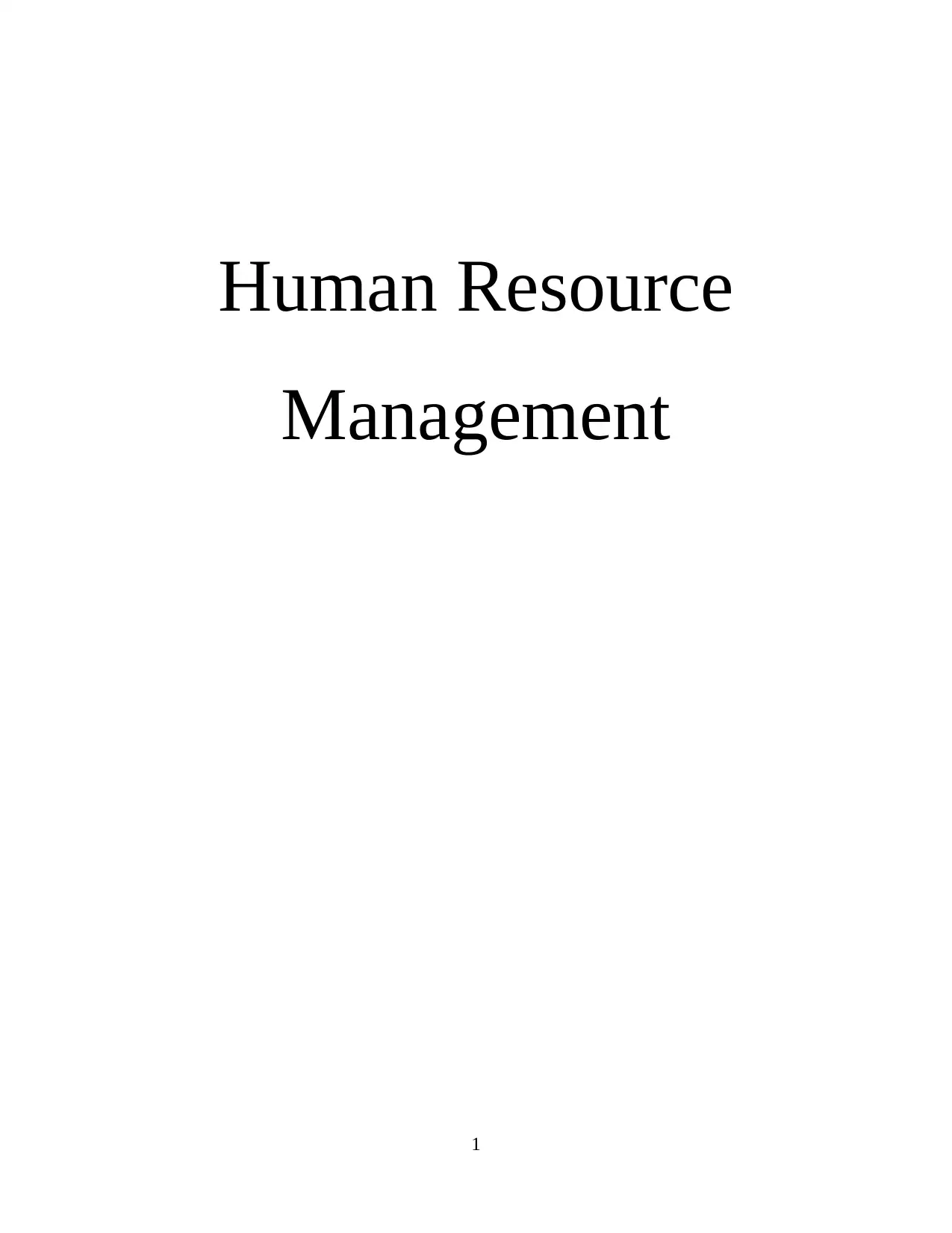
Human Resource
Management
1
Management
1
Secure Best Marks with AI Grader
Need help grading? Try our AI Grader for instant feedback on your assignments.
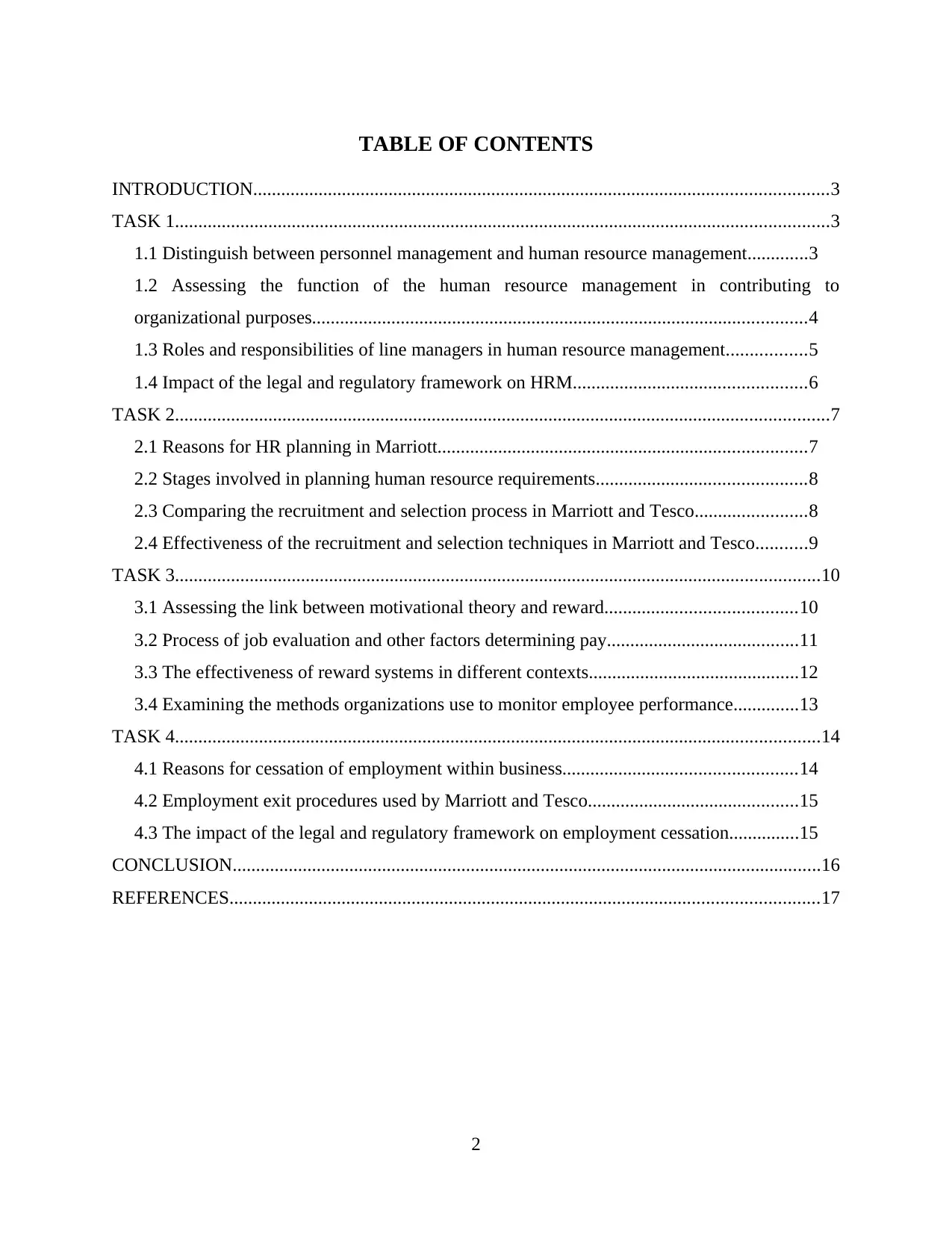
TABLE OF CONTENTS
INTRODUCTION...........................................................................................................................3
TASK 1............................................................................................................................................3
1.1 Distinguish between personnel management and human resource management.............3
1.2 Assessing the function of the human resource management in contributing to
organizational purposes..........................................................................................................4
1.3 Roles and responsibilities of line managers in human resource management.................5
1.4 Impact of the legal and regulatory framework on HRM..................................................6
TASK 2............................................................................................................................................7
2.1 Reasons for HR planning in Marriott...............................................................................7
2.2 Stages involved in planning human resource requirements.............................................8
2.3 Comparing the recruitment and selection process in Marriott and Tesco........................8
2.4 Effectiveness of the recruitment and selection techniques in Marriott and Tesco...........9
TASK 3..........................................................................................................................................10
3.1 Assessing the link between motivational theory and reward.........................................10
3.2 Process of job evaluation and other factors determining pay.........................................11
3.3 The effectiveness of reward systems in different contexts.............................................12
3.4 Examining the methods organizations use to monitor employee performance..............13
TASK 4..........................................................................................................................................14
4.1 Reasons for cessation of employment within business..................................................14
4.2 Employment exit procedures used by Marriott and Tesco.............................................15
4.3 The impact of the legal and regulatory framework on employment cessation...............15
CONCLUSION..............................................................................................................................16
REFERENCES..............................................................................................................................17
2
INTRODUCTION...........................................................................................................................3
TASK 1............................................................................................................................................3
1.1 Distinguish between personnel management and human resource management.............3
1.2 Assessing the function of the human resource management in contributing to
organizational purposes..........................................................................................................4
1.3 Roles and responsibilities of line managers in human resource management.................5
1.4 Impact of the legal and regulatory framework on HRM..................................................6
TASK 2............................................................................................................................................7
2.1 Reasons for HR planning in Marriott...............................................................................7
2.2 Stages involved in planning human resource requirements.............................................8
2.3 Comparing the recruitment and selection process in Marriott and Tesco........................8
2.4 Effectiveness of the recruitment and selection techniques in Marriott and Tesco...........9
TASK 3..........................................................................................................................................10
3.1 Assessing the link between motivational theory and reward.........................................10
3.2 Process of job evaluation and other factors determining pay.........................................11
3.3 The effectiveness of reward systems in different contexts.............................................12
3.4 Examining the methods organizations use to monitor employee performance..............13
TASK 4..........................................................................................................................................14
4.1 Reasons for cessation of employment within business..................................................14
4.2 Employment exit procedures used by Marriott and Tesco.............................................15
4.3 The impact of the legal and regulatory framework on employment cessation...............15
CONCLUSION..............................................................................................................................16
REFERENCES..............................................................................................................................17
2

INTRODUCTION
Human resource management (HRM) is the process through which employees can be
managed in a structured manner. It includes the processes such as recruitment, selection,
placement, induction, training and development, motivation, compensation, benefits, etc. It helps
in increasing the productivity of the organization by effective utilization of employees. It also
helps in improving the performance of the employees. Main objective of HRM is to acquire,
develop and retain best talent in the organization (Davenport, 2013). However, HR department of
enterprise is highly concentrating upon planning different policies and practices so that the set
goals can be attained. Also, it is crucial for firm to manage the human resources significantly and
value them in order to retain them for long term in business. Human resource professionals
involves all the employees in decision making process so that they make healthy relations with
them and grow the organization in an effective manner.
In this regard, present report has been prepared that involves discussion over HRM
practice within the context of Marriott Hotel UK. Further, the areas that are covered in this report
are differences among human resource management and personnel management, methods of
recruiting, rewarding employees in order to motivate and retain them and the mechanisms for the
cessation of employment (Delahaye, 2015).
TASK 1
1.1 Distinguish between personnel management and human resource management
HR manager of any organization plays a crucial role in determining the training and
development sessions to workers so that they can enhance their skills and capabilities up to a
great extent. HR department follows planning, recruiting, training and development programs in
order to keep the human resources efficient and improve their skills and knowledge effectively.
Here, personnel management can be stated as the process that focuses upon the development of
human resources so that functions of business can be carried out effectively (Hafiza and et. al.,
2011). Thus, the top management of Marriott provides rewards and bonuses to efficient workers
and encourage them. While, HRM possess a wider scope than personnel management and helps
in managing the functions of employees. Following is the difference between personnel and
human resource management are discussed underneath-
Personnel Management Human Resource Management
3
Human resource management (HRM) is the process through which employees can be
managed in a structured manner. It includes the processes such as recruitment, selection,
placement, induction, training and development, motivation, compensation, benefits, etc. It helps
in increasing the productivity of the organization by effective utilization of employees. It also
helps in improving the performance of the employees. Main objective of HRM is to acquire,
develop and retain best talent in the organization (Davenport, 2013). However, HR department of
enterprise is highly concentrating upon planning different policies and practices so that the set
goals can be attained. Also, it is crucial for firm to manage the human resources significantly and
value them in order to retain them for long term in business. Human resource professionals
involves all the employees in decision making process so that they make healthy relations with
them and grow the organization in an effective manner.
In this regard, present report has been prepared that involves discussion over HRM
practice within the context of Marriott Hotel UK. Further, the areas that are covered in this report
are differences among human resource management and personnel management, methods of
recruiting, rewarding employees in order to motivate and retain them and the mechanisms for the
cessation of employment (Delahaye, 2015).
TASK 1
1.1 Distinguish between personnel management and human resource management
HR manager of any organization plays a crucial role in determining the training and
development sessions to workers so that they can enhance their skills and capabilities up to a
great extent. HR department follows planning, recruiting, training and development programs in
order to keep the human resources efficient and improve their skills and knowledge effectively.
Here, personnel management can be stated as the process that focuses upon the development of
human resources so that functions of business can be carried out effectively (Hafiza and et. al.,
2011). Thus, the top management of Marriott provides rewards and bonuses to efficient workers
and encourage them. While, HRM possess a wider scope than personnel management and helps
in managing the functions of employees. Following is the difference between personnel and
human resource management are discussed underneath-
Personnel Management Human Resource Management
3
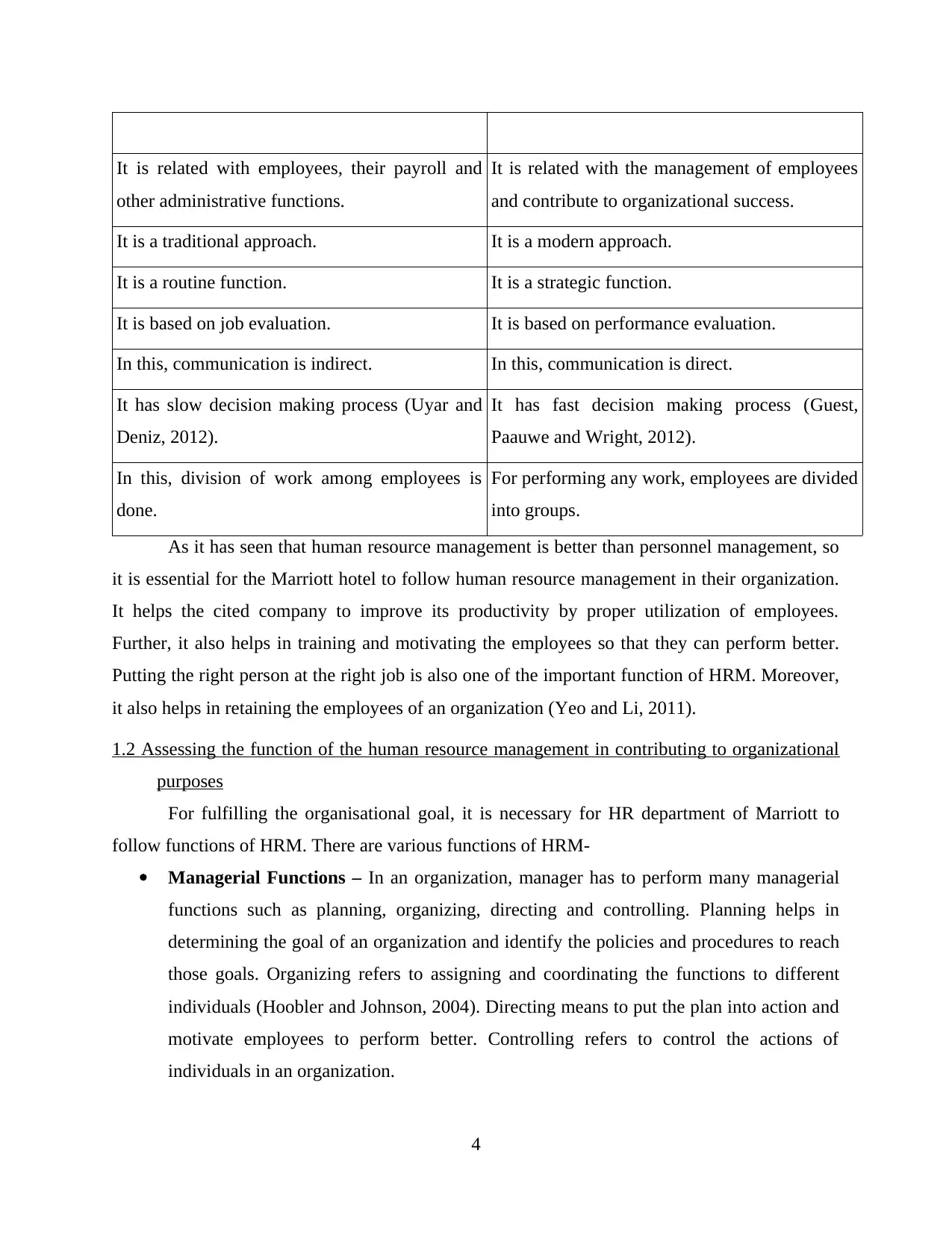
It is related with employees, their payroll and
other administrative functions.
It is related with the management of employees
and contribute to organizational success.
It is a traditional approach. It is a modern approach.
It is a routine function. It is a strategic function.
It is based on job evaluation. It is based on performance evaluation.
In this, communication is indirect. In this, communication is direct.
It has slow decision making process (Uyar and
Deniz, 2012).
It has fast decision making process (Guest,
Paauwe and Wright, 2012).
In this, division of work among employees is
done.
For performing any work, employees are divided
into groups.
As it has seen that human resource management is better than personnel management, so
it is essential for the Marriott hotel to follow human resource management in their organization.
It helps the cited company to improve its productivity by proper utilization of employees.
Further, it also helps in training and motivating the employees so that they can perform better.
Putting the right person at the right job is also one of the important function of HRM. Moreover,
it also helps in retaining the employees of an organization (Yeo and Li, 2011).
1.2 Assessing the function of the human resource management in contributing to organizational
purposes
For fulfilling the organisational goal, it is necessary for HR department of Marriott to
follow functions of HRM. There are various functions of HRM-
Managerial Functions – In an organization, manager has to perform many managerial
functions such as planning, organizing, directing and controlling. Planning helps in
determining the goal of an organization and identify the policies and procedures to reach
those goals. Organizing refers to assigning and coordinating the functions to different
individuals (Hoobler and Johnson, 2004). Directing means to put the plan into action and
motivate employees to perform better. Controlling refers to control the actions of
individuals in an organization.
4
other administrative functions.
It is related with the management of employees
and contribute to organizational success.
It is a traditional approach. It is a modern approach.
It is a routine function. It is a strategic function.
It is based on job evaluation. It is based on performance evaluation.
In this, communication is indirect. In this, communication is direct.
It has slow decision making process (Uyar and
Deniz, 2012).
It has fast decision making process (Guest,
Paauwe and Wright, 2012).
In this, division of work among employees is
done.
For performing any work, employees are divided
into groups.
As it has seen that human resource management is better than personnel management, so
it is essential for the Marriott hotel to follow human resource management in their organization.
It helps the cited company to improve its productivity by proper utilization of employees.
Further, it also helps in training and motivating the employees so that they can perform better.
Putting the right person at the right job is also one of the important function of HRM. Moreover,
it also helps in retaining the employees of an organization (Yeo and Li, 2011).
1.2 Assessing the function of the human resource management in contributing to organizational
purposes
For fulfilling the organisational goal, it is necessary for HR department of Marriott to
follow functions of HRM. There are various functions of HRM-
Managerial Functions – In an organization, manager has to perform many managerial
functions such as planning, organizing, directing and controlling. Planning helps in
determining the goal of an organization and identify the policies and procedures to reach
those goals. Organizing refers to assigning and coordinating the functions to different
individuals (Hoobler and Johnson, 2004). Directing means to put the plan into action and
motivate employees to perform better. Controlling refers to control the actions of
individuals in an organization.
4
Secure Best Marks with AI Grader
Need help grading? Try our AI Grader for instant feedback on your assignments.
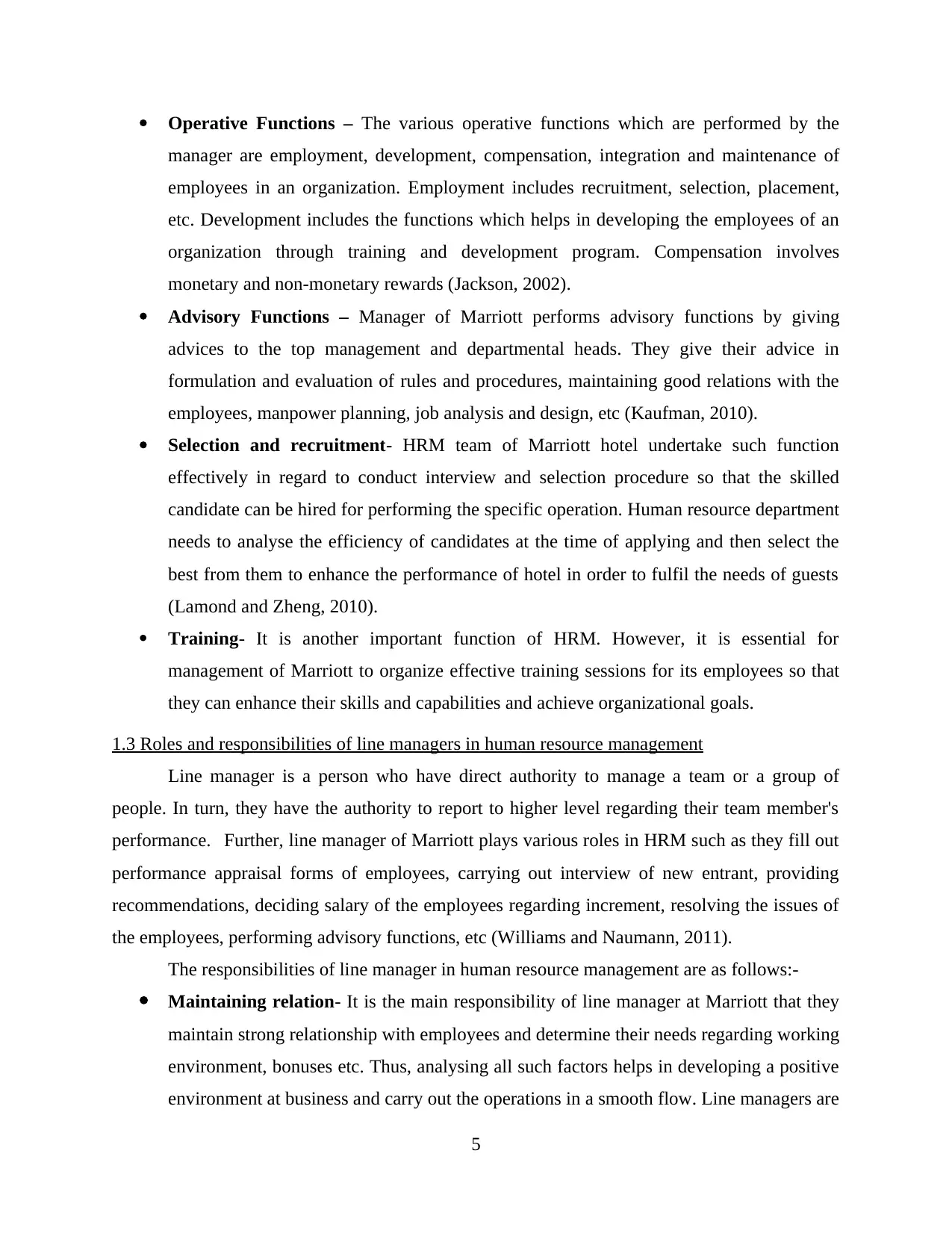
Operative Functions – The various operative functions which are performed by the
manager are employment, development, compensation, integration and maintenance of
employees in an organization. Employment includes recruitment, selection, placement,
etc. Development includes the functions which helps in developing the employees of an
organization through training and development program. Compensation involves
monetary and non-monetary rewards (Jackson, 2002).
Advisory Functions – Manager of Marriott performs advisory functions by giving
advices to the top management and departmental heads. They give their advice in
formulation and evaluation of rules and procedures, maintaining good relations with the
employees, manpower planning, job analysis and design, etc (Kaufman, 2010).
Selection and recruitment- HRM team of Marriott hotel undertake such function
effectively in regard to conduct interview and selection procedure so that the skilled
candidate can be hired for performing the specific operation. Human resource department
needs to analyse the efficiency of candidates at the time of applying and then select the
best from them to enhance the performance of hotel in order to fulfil the needs of guests
(Lamond and Zheng, 2010).
Training- It is another important function of HRM. However, it is essential for
management of Marriott to organize effective training sessions for its employees so that
they can enhance their skills and capabilities and achieve organizational goals.
1.3 Roles and responsibilities of line managers in human resource management
Line manager is a person who have direct authority to manage a team or a group of
people. In turn, they have the authority to report to higher level regarding their team member's
performance. Further, line manager of Marriott plays various roles in HRM such as they fill out
performance appraisal forms of employees, carrying out interview of new entrant, providing
recommendations, deciding salary of the employees regarding increment, resolving the issues of
the employees, performing advisory functions, etc (Williams and Naumann, 2011).
The responsibilities of line manager in human resource management are as follows:-
Maintaining relation- It is the main responsibility of line manager at Marriott that they
maintain strong relationship with employees and determine their needs regarding working
environment, bonuses etc. Thus, analysing all such factors helps in developing a positive
environment at business and carry out the operations in a smooth flow. Line managers are
5
manager are employment, development, compensation, integration and maintenance of
employees in an organization. Employment includes recruitment, selection, placement,
etc. Development includes the functions which helps in developing the employees of an
organization through training and development program. Compensation involves
monetary and non-monetary rewards (Jackson, 2002).
Advisory Functions – Manager of Marriott performs advisory functions by giving
advices to the top management and departmental heads. They give their advice in
formulation and evaluation of rules and procedures, maintaining good relations with the
employees, manpower planning, job analysis and design, etc (Kaufman, 2010).
Selection and recruitment- HRM team of Marriott hotel undertake such function
effectively in regard to conduct interview and selection procedure so that the skilled
candidate can be hired for performing the specific operation. Human resource department
needs to analyse the efficiency of candidates at the time of applying and then select the
best from them to enhance the performance of hotel in order to fulfil the needs of guests
(Lamond and Zheng, 2010).
Training- It is another important function of HRM. However, it is essential for
management of Marriott to organize effective training sessions for its employees so that
they can enhance their skills and capabilities and achieve organizational goals.
1.3 Roles and responsibilities of line managers in human resource management
Line manager is a person who have direct authority to manage a team or a group of
people. In turn, they have the authority to report to higher level regarding their team member's
performance. Further, line manager of Marriott plays various roles in HRM such as they fill out
performance appraisal forms of employees, carrying out interview of new entrant, providing
recommendations, deciding salary of the employees regarding increment, resolving the issues of
the employees, performing advisory functions, etc (Williams and Naumann, 2011).
The responsibilities of line manager in human resource management are as follows:-
Maintaining relation- It is the main responsibility of line manager at Marriott that they
maintain strong relationship with employees and determine their needs regarding working
environment, bonuses etc. Thus, analysing all such factors helps in developing a positive
environment at business and carry out the operations in a smooth flow. Line managers are
5
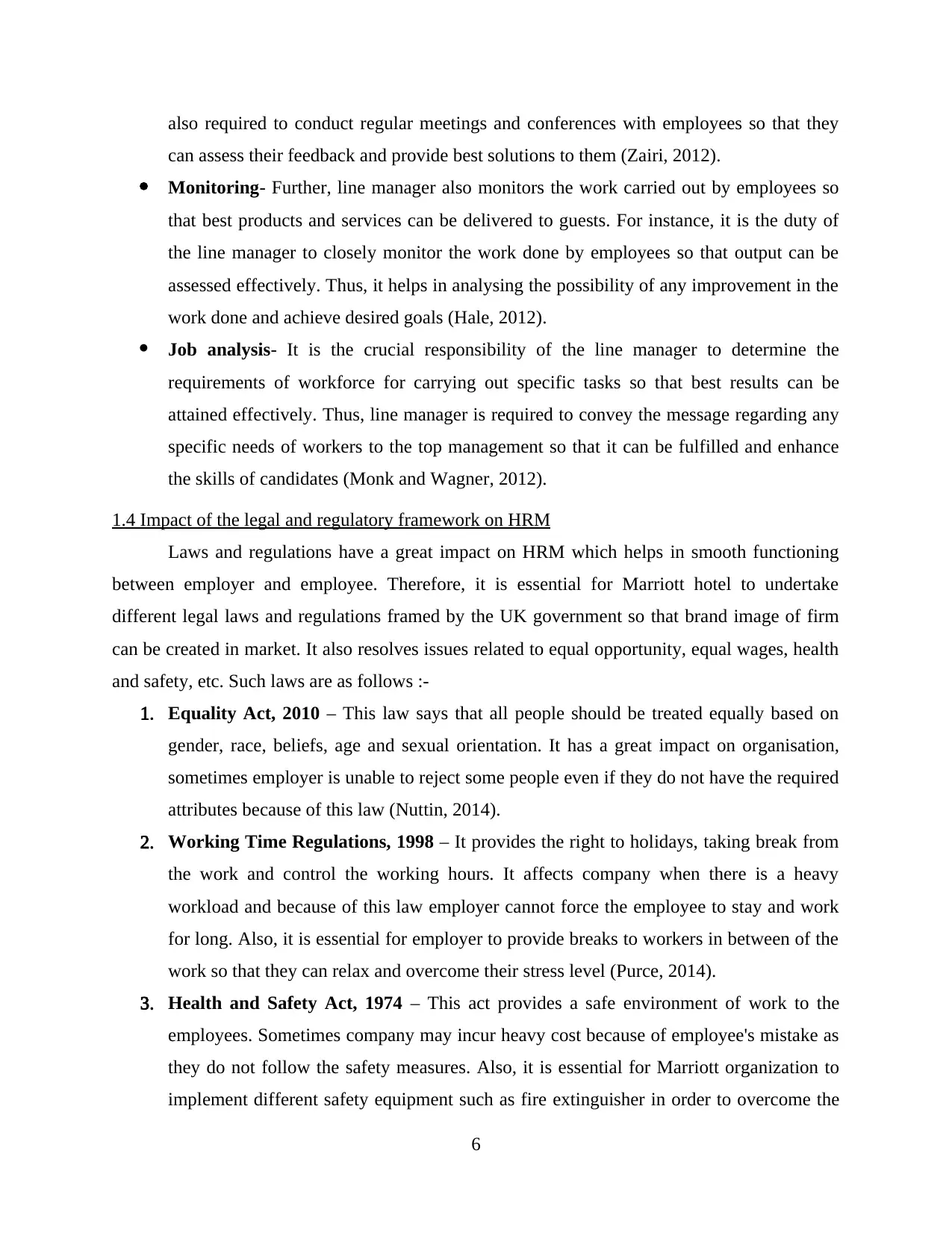
also required to conduct regular meetings and conferences with employees so that they
can assess their feedback and provide best solutions to them (Zairi, 2012).
Monitoring- Further, line manager also monitors the work carried out by employees so
that best products and services can be delivered to guests. For instance, it is the duty of
the line manager to closely monitor the work done by employees so that output can be
assessed effectively. Thus, it helps in analysing the possibility of any improvement in the
work done and achieve desired goals (Hale, 2012).
Job analysis- It is the crucial responsibility of the line manager to determine the
requirements of workforce for carrying out specific tasks so that best results can be
attained effectively. Thus, line manager is required to convey the message regarding any
specific needs of workers to the top management so that it can be fulfilled and enhance
the skills of candidates (Monk and Wagner, 2012).
1.4 Impact of the legal and regulatory framework on HRM
Laws and regulations have a great impact on HRM which helps in smooth functioning
between employer and employee. Therefore, it is essential for Marriott hotel to undertake
different legal laws and regulations framed by the UK government so that brand image of firm
can be created in market. It also resolves issues related to equal opportunity, equal wages, health
and safety, etc. Such laws are as follows :-
1. Equality Act, 2010 – This law says that all people should be treated equally based on
gender, race, beliefs, age and sexual orientation. It has a great impact on organisation,
sometimes employer is unable to reject some people even if they do not have the required
attributes because of this law (Nuttin, 2014).
2. Working Time Regulations, 1998 – It provides the right to holidays, taking break from
the work and control the working hours. It affects company when there is a heavy
workload and because of this law employer cannot force the employee to stay and work
for long. Also, it is essential for employer to provide breaks to workers in between of the
work so that they can relax and overcome their stress level (Purce, 2014).
3. Health and Safety Act, 1974 – This act provides a safe environment of work to the
employees. Sometimes company may incur heavy cost because of employee's mistake as
they do not follow the safety measures. Also, it is essential for Marriott organization to
implement different safety equipment such as fire extinguisher in order to overcome the
6
can assess their feedback and provide best solutions to them (Zairi, 2012).
Monitoring- Further, line manager also monitors the work carried out by employees so
that best products and services can be delivered to guests. For instance, it is the duty of
the line manager to closely monitor the work done by employees so that output can be
assessed effectively. Thus, it helps in analysing the possibility of any improvement in the
work done and achieve desired goals (Hale, 2012).
Job analysis- It is the crucial responsibility of the line manager to determine the
requirements of workforce for carrying out specific tasks so that best results can be
attained effectively. Thus, line manager is required to convey the message regarding any
specific needs of workers to the top management so that it can be fulfilled and enhance
the skills of candidates (Monk and Wagner, 2012).
1.4 Impact of the legal and regulatory framework on HRM
Laws and regulations have a great impact on HRM which helps in smooth functioning
between employer and employee. Therefore, it is essential for Marriott hotel to undertake
different legal laws and regulations framed by the UK government so that brand image of firm
can be created in market. It also resolves issues related to equal opportunity, equal wages, health
and safety, etc. Such laws are as follows :-
1. Equality Act, 2010 – This law says that all people should be treated equally based on
gender, race, beliefs, age and sexual orientation. It has a great impact on organisation,
sometimes employer is unable to reject some people even if they do not have the required
attributes because of this law (Nuttin, 2014).
2. Working Time Regulations, 1998 – It provides the right to holidays, taking break from
the work and control the working hours. It affects company when there is a heavy
workload and because of this law employer cannot force the employee to stay and work
for long. Also, it is essential for employer to provide breaks to workers in between of the
work so that they can relax and overcome their stress level (Purce, 2014).
3. Health and Safety Act, 1974 – This act provides a safe environment of work to the
employees. Sometimes company may incur heavy cost because of employee's mistake as
they do not follow the safety measures. Also, it is essential for Marriott organization to
implement different safety equipment such as fire extinguisher in order to overcome the
6
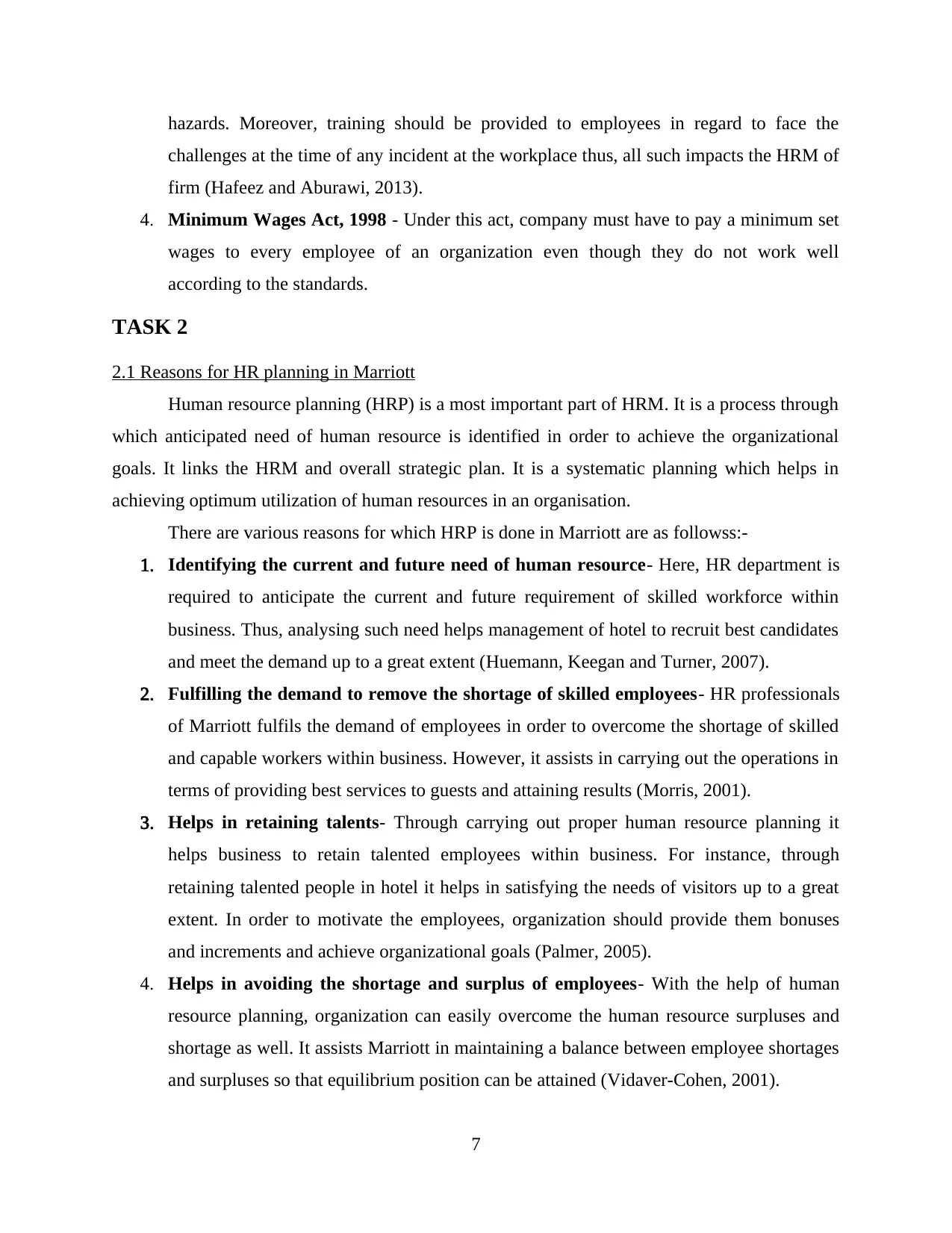
hazards. Moreover, training should be provided to employees in regard to face the
challenges at the time of any incident at the workplace thus, all such impacts the HRM of
firm (Hafeez and Aburawi, 2013).
4. Minimum Wages Act, 1998 - Under this act, company must have to pay a minimum set
wages to every employee of an organization even though they do not work well
according to the standards.
TASK 2
2.1 Reasons for HR planning in Marriott
Human resource planning (HRP) is a most important part of HRM. It is a process through
which anticipated need of human resource is identified in order to achieve the organizational
goals. It links the HRM and overall strategic plan. It is a systematic planning which helps in
achieving optimum utilization of human resources in an organisation.
There are various reasons for which HRP is done in Marriott are as followss:-
1. Identifying the current and future need of human resource- Here, HR department is
required to anticipate the current and future requirement of skilled workforce within
business. Thus, analysing such need helps management of hotel to recruit best candidates
and meet the demand up to a great extent (Huemann, Keegan and Turner, 2007).
2. Fulfilling the demand to remove the shortage of skilled employees- HR professionals
of Marriott fulfils the demand of employees in order to overcome the shortage of skilled
and capable workers within business. However, it assists in carrying out the operations in
terms of providing best services to guests and attaining results (Morris, 2001).
3. Helps in retaining talents- Through carrying out proper human resource planning it
helps business to retain talented employees within business. For instance, through
retaining talented people in hotel it helps in satisfying the needs of visitors up to a great
extent. In order to motivate the employees, organization should provide them bonuses
and increments and achieve organizational goals (Palmer, 2005).
4. Helps in avoiding the shortage and surplus of employees- With the help of human
resource planning, organization can easily overcome the human resource surpluses and
shortage as well. It assists Marriott in maintaining a balance between employee shortages
and surpluses so that equilibrium position can be attained (Vidaver-Cohen, 2001).
7
challenges at the time of any incident at the workplace thus, all such impacts the HRM of
firm (Hafeez and Aburawi, 2013).
4. Minimum Wages Act, 1998 - Under this act, company must have to pay a minimum set
wages to every employee of an organization even though they do not work well
according to the standards.
TASK 2
2.1 Reasons for HR planning in Marriott
Human resource planning (HRP) is a most important part of HRM. It is a process through
which anticipated need of human resource is identified in order to achieve the organizational
goals. It links the HRM and overall strategic plan. It is a systematic planning which helps in
achieving optimum utilization of human resources in an organisation.
There are various reasons for which HRP is done in Marriott are as followss:-
1. Identifying the current and future need of human resource- Here, HR department is
required to anticipate the current and future requirement of skilled workforce within
business. Thus, analysing such need helps management of hotel to recruit best candidates
and meet the demand up to a great extent (Huemann, Keegan and Turner, 2007).
2. Fulfilling the demand to remove the shortage of skilled employees- HR professionals
of Marriott fulfils the demand of employees in order to overcome the shortage of skilled
and capable workers within business. However, it assists in carrying out the operations in
terms of providing best services to guests and attaining results (Morris, 2001).
3. Helps in retaining talents- Through carrying out proper human resource planning it
helps business to retain talented employees within business. For instance, through
retaining talented people in hotel it helps in satisfying the needs of visitors up to a great
extent. In order to motivate the employees, organization should provide them bonuses
and increments and achieve organizational goals (Palmer, 2005).
4. Helps in avoiding the shortage and surplus of employees- With the help of human
resource planning, organization can easily overcome the human resource surpluses and
shortage as well. It assists Marriott in maintaining a balance between employee shortages
and surpluses so that equilibrium position can be attained (Vidaver-Cohen, 2001).
7
Paraphrase This Document
Need a fresh take? Get an instant paraphrase of this document with our AI Paraphraser
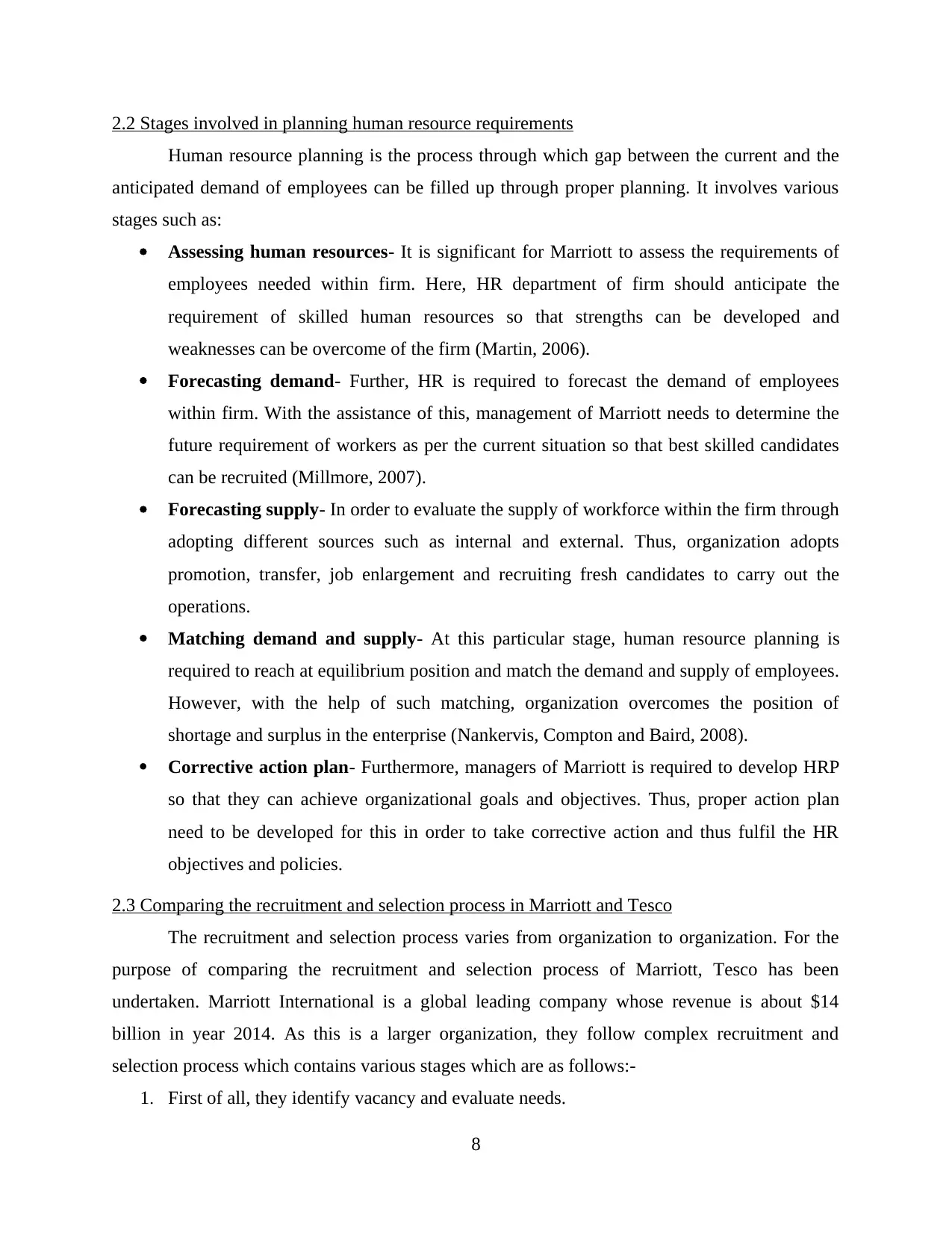
2.2 Stages involved in planning human resource requirements
Human resource planning is the process through which gap between the current and the
anticipated demand of employees can be filled up through proper planning. It involves various
stages such as:
Assessing human resources- It is significant for Marriott to assess the requirements of
employees needed within firm. Here, HR department of firm should anticipate the
requirement of skilled human resources so that strengths can be developed and
weaknesses can be overcome of the firm (Martin, 2006).
Forecasting demand- Further, HR is required to forecast the demand of employees
within firm. With the assistance of this, management of Marriott needs to determine the
future requirement of workers as per the current situation so that best skilled candidates
can be recruited (Millmore, 2007).
Forecasting supply- In order to evaluate the supply of workforce within the firm through
adopting different sources such as internal and external. Thus, organization adopts
promotion, transfer, job enlargement and recruiting fresh candidates to carry out the
operations.
Matching demand and supply- At this particular stage, human resource planning is
required to reach at equilibrium position and match the demand and supply of employees.
However, with the help of such matching, organization overcomes the position of
shortage and surplus in the enterprise (Nankervis, Compton and Baird, 2008).
Corrective action plan- Furthermore, managers of Marriott is required to develop HRP
so that they can achieve organizational goals and objectives. Thus, proper action plan
need to be developed for this in order to take corrective action and thus fulfil the HR
objectives and policies.
2.3 Comparing the recruitment and selection process in Marriott and Tesco
The recruitment and selection process varies from organization to organization. For the
purpose of comparing the recruitment and selection process of Marriott, Tesco has been
undertaken. Marriott International is a global leading company whose revenue is about $14
billion in year 2014. As this is a larger organization, they follow complex recruitment and
selection process which contains various stages which are as follows:-
1. First of all, they identify vacancy and evaluate needs.
8
Human resource planning is the process through which gap between the current and the
anticipated demand of employees can be filled up through proper planning. It involves various
stages such as:
Assessing human resources- It is significant for Marriott to assess the requirements of
employees needed within firm. Here, HR department of firm should anticipate the
requirement of skilled human resources so that strengths can be developed and
weaknesses can be overcome of the firm (Martin, 2006).
Forecasting demand- Further, HR is required to forecast the demand of employees
within firm. With the assistance of this, management of Marriott needs to determine the
future requirement of workers as per the current situation so that best skilled candidates
can be recruited (Millmore, 2007).
Forecasting supply- In order to evaluate the supply of workforce within the firm through
adopting different sources such as internal and external. Thus, organization adopts
promotion, transfer, job enlargement and recruiting fresh candidates to carry out the
operations.
Matching demand and supply- At this particular stage, human resource planning is
required to reach at equilibrium position and match the demand and supply of employees.
However, with the help of such matching, organization overcomes the position of
shortage and surplus in the enterprise (Nankervis, Compton and Baird, 2008).
Corrective action plan- Furthermore, managers of Marriott is required to develop HRP
so that they can achieve organizational goals and objectives. Thus, proper action plan
need to be developed for this in order to take corrective action and thus fulfil the HR
objectives and policies.
2.3 Comparing the recruitment and selection process in Marriott and Tesco
The recruitment and selection process varies from organization to organization. For the
purpose of comparing the recruitment and selection process of Marriott, Tesco has been
undertaken. Marriott International is a global leading company whose revenue is about $14
billion in year 2014. As this is a larger organization, they follow complex recruitment and
selection process which contains various stages which are as follows:-
1. First of all, they identify vacancy and evaluate needs.
8
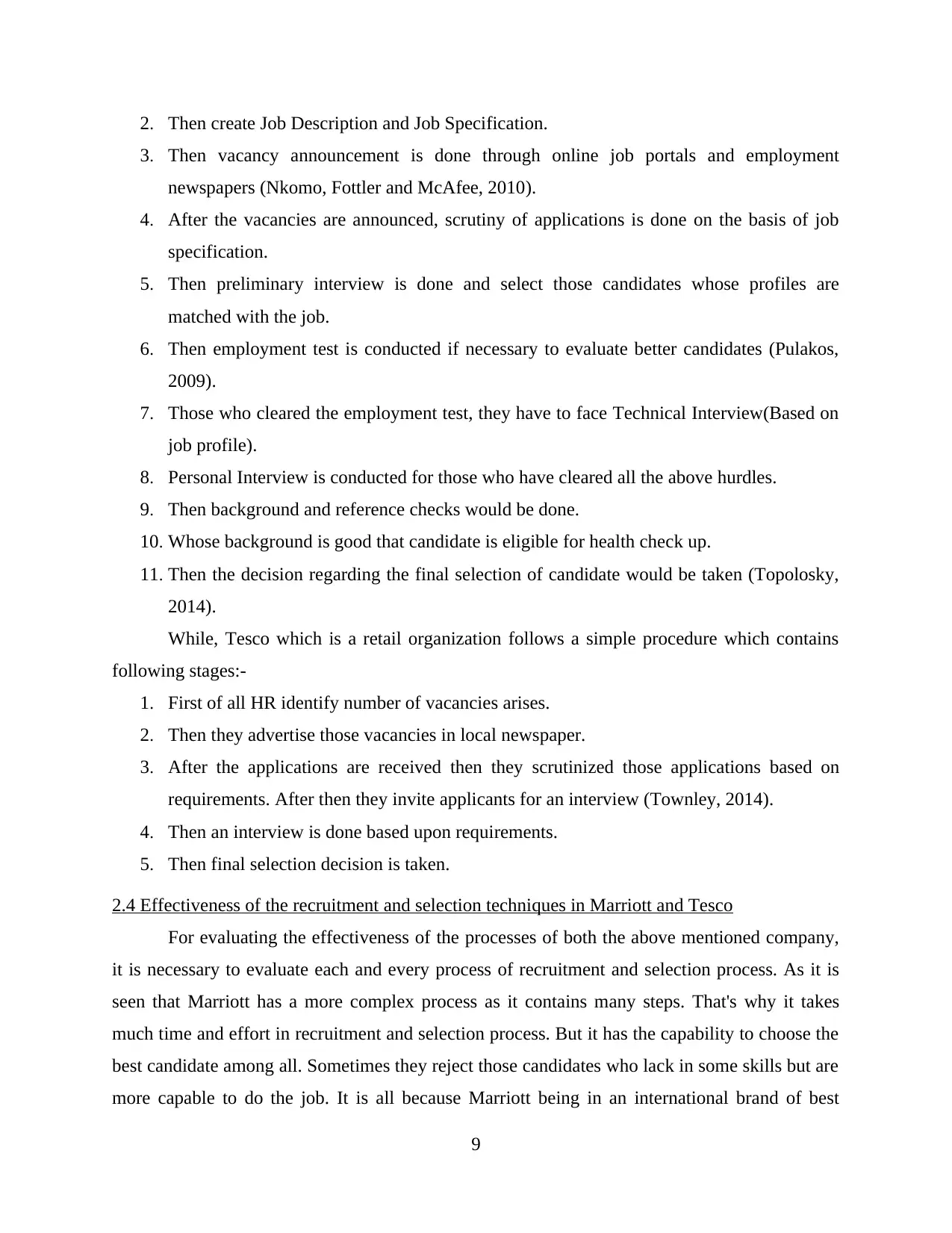
2. Then create Job Description and Job Specification.
3. Then vacancy announcement is done through online job portals and employment
newspapers (Nkomo, Fottler and McAfee, 2010).
4. After the vacancies are announced, scrutiny of applications is done on the basis of job
specification.
5. Then preliminary interview is done and select those candidates whose profiles are
matched with the job.
6. Then employment test is conducted if necessary to evaluate better candidates (Pulakos,
2009).
7. Those who cleared the employment test, they have to face Technical Interview(Based on
job profile).
8. Personal Interview is conducted for those who have cleared all the above hurdles.
9. Then background and reference checks would be done.
10. Whose background is good that candidate is eligible for health check up.
11. Then the decision regarding the final selection of candidate would be taken (Topolosky,
2014).
While, Tesco which is a retail organization follows a simple procedure which contains
following stages:-
1. First of all HR identify number of vacancies arises.
2. Then they advertise those vacancies in local newspaper.
3. After the applications are received then they scrutinized those applications based on
requirements. After then they invite applicants for an interview (Townley, 2014).
4. Then an interview is done based upon requirements.
5. Then final selection decision is taken.
2.4 Effectiveness of the recruitment and selection techniques in Marriott and Tesco
For evaluating the effectiveness of the processes of both the above mentioned company,
it is necessary to evaluate each and every process of recruitment and selection process. As it is
seen that Marriott has a more complex process as it contains many steps. That's why it takes
much time and effort in recruitment and selection process. But it has the capability to choose the
best candidate among all. Sometimes they reject those candidates who lack in some skills but are
more capable to do the job. It is all because Marriott being in an international brand of best
9
3. Then vacancy announcement is done through online job portals and employment
newspapers (Nkomo, Fottler and McAfee, 2010).
4. After the vacancies are announced, scrutiny of applications is done on the basis of job
specification.
5. Then preliminary interview is done and select those candidates whose profiles are
matched with the job.
6. Then employment test is conducted if necessary to evaluate better candidates (Pulakos,
2009).
7. Those who cleared the employment test, they have to face Technical Interview(Based on
job profile).
8. Personal Interview is conducted for those who have cleared all the above hurdles.
9. Then background and reference checks would be done.
10. Whose background is good that candidate is eligible for health check up.
11. Then the decision regarding the final selection of candidate would be taken (Topolosky,
2014).
While, Tesco which is a retail organization follows a simple procedure which contains
following stages:-
1. First of all HR identify number of vacancies arises.
2. Then they advertise those vacancies in local newspaper.
3. After the applications are received then they scrutinized those applications based on
requirements. After then they invite applicants for an interview (Townley, 2014).
4. Then an interview is done based upon requirements.
5. Then final selection decision is taken.
2.4 Effectiveness of the recruitment and selection techniques in Marriott and Tesco
For evaluating the effectiveness of the processes of both the above mentioned company,
it is necessary to evaluate each and every process of recruitment and selection process. As it is
seen that Marriott has a more complex process as it contains many steps. That's why it takes
much time and effort in recruitment and selection process. But it has the capability to choose the
best candidate among all. Sometimes they reject those candidates who lack in some skills but are
more capable to do the job. It is all because Marriott being in an international brand of best
9
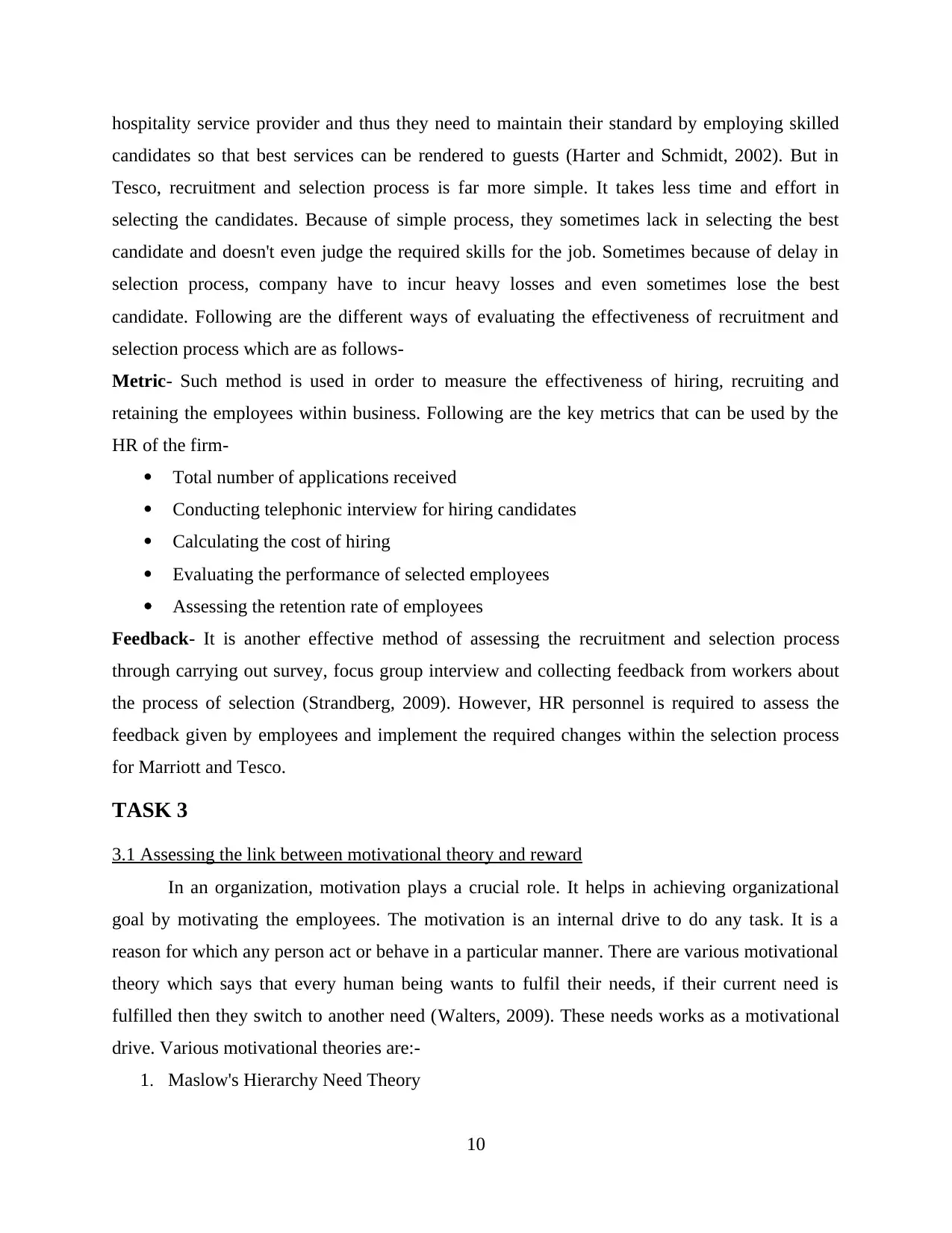
hospitality service provider and thus they need to maintain their standard by employing skilled
candidates so that best services can be rendered to guests (Harter and Schmidt, 2002). But in
Tesco, recruitment and selection process is far more simple. It takes less time and effort in
selecting the candidates. Because of simple process, they sometimes lack in selecting the best
candidate and doesn't even judge the required skills for the job. Sometimes because of delay in
selection process, company have to incur heavy losses and even sometimes lose the best
candidate. Following are the different ways of evaluating the effectiveness of recruitment and
selection process which are as follows-
Metric- Such method is used in order to measure the effectiveness of hiring, recruiting and
retaining the employees within business. Following are the key metrics that can be used by the
HR of the firm-
Total number of applications received
Conducting telephonic interview for hiring candidates
Calculating the cost of hiring
Evaluating the performance of selected employees
Assessing the retention rate of employees
Feedback- It is another effective method of assessing the recruitment and selection process
through carrying out survey, focus group interview and collecting feedback from workers about
the process of selection (Strandberg, 2009). However, HR personnel is required to assess the
feedback given by employees and implement the required changes within the selection process
for Marriott and Tesco.
TASK 3
3.1 Assessing the link between motivational theory and reward
In an organization, motivation plays a crucial role. It helps in achieving organizational
goal by motivating the employees. The motivation is an internal drive to do any task. It is a
reason for which any person act or behave in a particular manner. There are various motivational
theory which says that every human being wants to fulfil their needs, if their current need is
fulfilled then they switch to another need (Walters, 2009). These needs works as a motivational
drive. Various motivational theories are:-
1. Maslow's Hierarchy Need Theory
10
candidates so that best services can be rendered to guests (Harter and Schmidt, 2002). But in
Tesco, recruitment and selection process is far more simple. It takes less time and effort in
selecting the candidates. Because of simple process, they sometimes lack in selecting the best
candidate and doesn't even judge the required skills for the job. Sometimes because of delay in
selection process, company have to incur heavy losses and even sometimes lose the best
candidate. Following are the different ways of evaluating the effectiveness of recruitment and
selection process which are as follows-
Metric- Such method is used in order to measure the effectiveness of hiring, recruiting and
retaining the employees within business. Following are the key metrics that can be used by the
HR of the firm-
Total number of applications received
Conducting telephonic interview for hiring candidates
Calculating the cost of hiring
Evaluating the performance of selected employees
Assessing the retention rate of employees
Feedback- It is another effective method of assessing the recruitment and selection process
through carrying out survey, focus group interview and collecting feedback from workers about
the process of selection (Strandberg, 2009). However, HR personnel is required to assess the
feedback given by employees and implement the required changes within the selection process
for Marriott and Tesco.
TASK 3
3.1 Assessing the link between motivational theory and reward
In an organization, motivation plays a crucial role. It helps in achieving organizational
goal by motivating the employees. The motivation is an internal drive to do any task. It is a
reason for which any person act or behave in a particular manner. There are various motivational
theory which says that every human being wants to fulfil their needs, if their current need is
fulfilled then they switch to another need (Walters, 2009). These needs works as a motivational
drive. Various motivational theories are:-
1. Maslow's Hierarchy Need Theory
10
Secure Best Marks with AI Grader
Need help grading? Try our AI Grader for instant feedback on your assignments.
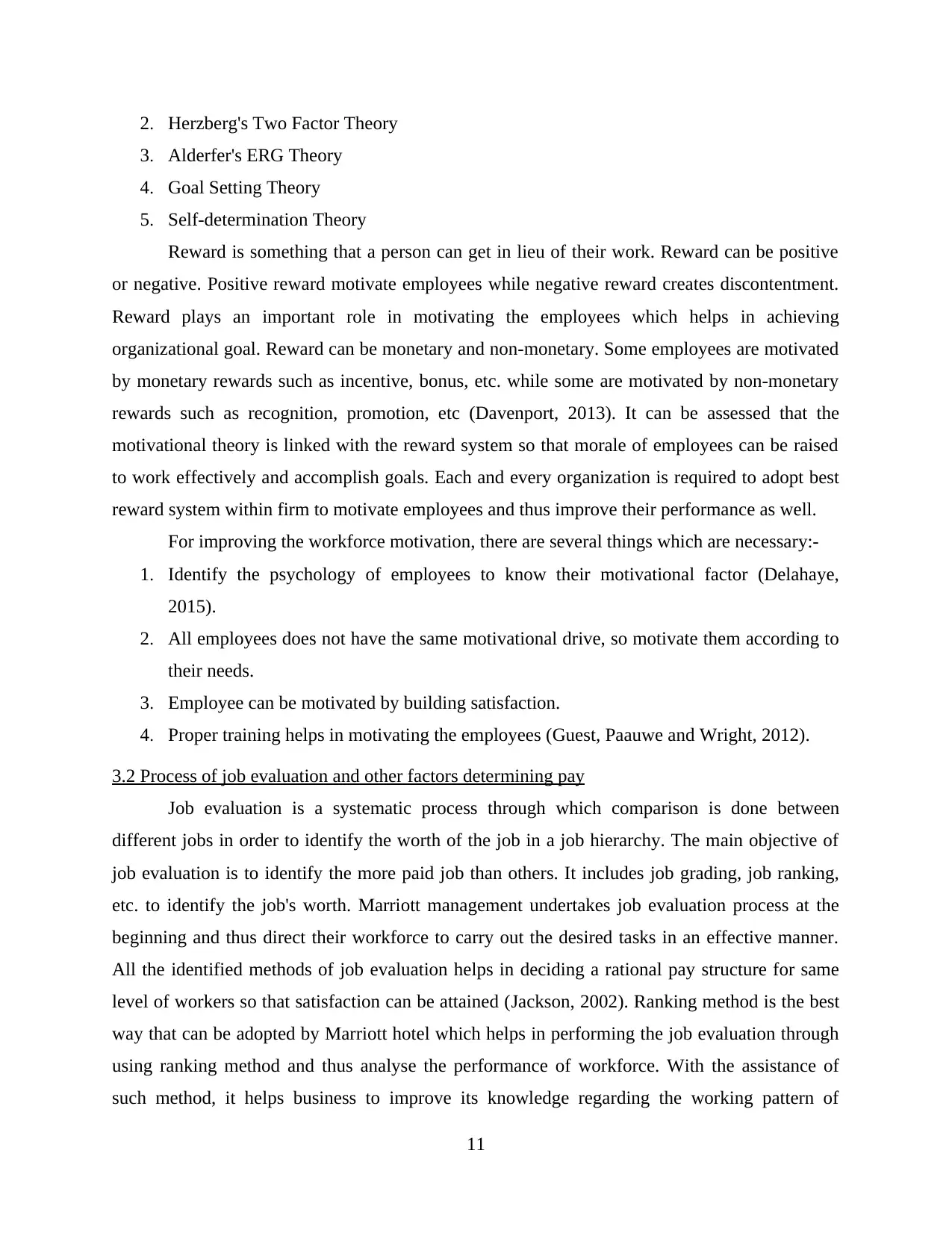
2. Herzberg's Two Factor Theory
3. Alderfer's ERG Theory
4. Goal Setting Theory
5. Self-determination Theory
Reward is something that a person can get in lieu of their work. Reward can be positive
or negative. Positive reward motivate employees while negative reward creates discontentment.
Reward plays an important role in motivating the employees which helps in achieving
organizational goal. Reward can be monetary and non-monetary. Some employees are motivated
by monetary rewards such as incentive, bonus, etc. while some are motivated by non-monetary
rewards such as recognition, promotion, etc (Davenport, 2013). It can be assessed that the
motivational theory is linked with the reward system so that morale of employees can be raised
to work effectively and accomplish goals. Each and every organization is required to adopt best
reward system within firm to motivate employees and thus improve their performance as well.
For improving the workforce motivation, there are several things which are necessary:-
1. Identify the psychology of employees to know their motivational factor (Delahaye,
2015).
2. All employees does not have the same motivational drive, so motivate them according to
their needs.
3. Employee can be motivated by building satisfaction.
4. Proper training helps in motivating the employees (Guest, Paauwe and Wright, 2012).
3.2 Process of job evaluation and other factors determining pay
Job evaluation is a systematic process through which comparison is done between
different jobs in order to identify the worth of the job in a job hierarchy. The main objective of
job evaluation is to identify the more paid job than others. It includes job grading, job ranking,
etc. to identify the job's worth. Marriott management undertakes job evaluation process at the
beginning and thus direct their workforce to carry out the desired tasks in an effective manner.
All the identified methods of job evaluation helps in deciding a rational pay structure for same
level of workers so that satisfaction can be attained (Jackson, 2002). Ranking method is the best
way that can be adopted by Marriott hotel which helps in performing the job evaluation through
using ranking method and thus analyse the performance of workforce. With the assistance of
such method, it helps business to improve its knowledge regarding the working pattern of
11
3. Alderfer's ERG Theory
4. Goal Setting Theory
5. Self-determination Theory
Reward is something that a person can get in lieu of their work. Reward can be positive
or negative. Positive reward motivate employees while negative reward creates discontentment.
Reward plays an important role in motivating the employees which helps in achieving
organizational goal. Reward can be monetary and non-monetary. Some employees are motivated
by monetary rewards such as incentive, bonus, etc. while some are motivated by non-monetary
rewards such as recognition, promotion, etc (Davenport, 2013). It can be assessed that the
motivational theory is linked with the reward system so that morale of employees can be raised
to work effectively and accomplish goals. Each and every organization is required to adopt best
reward system within firm to motivate employees and thus improve their performance as well.
For improving the workforce motivation, there are several things which are necessary:-
1. Identify the psychology of employees to know their motivational factor (Delahaye,
2015).
2. All employees does not have the same motivational drive, so motivate them according to
their needs.
3. Employee can be motivated by building satisfaction.
4. Proper training helps in motivating the employees (Guest, Paauwe and Wright, 2012).
3.2 Process of job evaluation and other factors determining pay
Job evaluation is a systematic process through which comparison is done between
different jobs in order to identify the worth of the job in a job hierarchy. The main objective of
job evaluation is to identify the more paid job than others. It includes job grading, job ranking,
etc. to identify the job's worth. Marriott management undertakes job evaluation process at the
beginning and thus direct their workforce to carry out the desired tasks in an effective manner.
All the identified methods of job evaluation helps in deciding a rational pay structure for same
level of workers so that satisfaction can be attained (Jackson, 2002). Ranking method is the best
way that can be adopted by Marriott hotel which helps in performing the job evaluation through
using ranking method and thus analyse the performance of workforce. With the assistance of
such method, it helps business to improve its knowledge regarding the working pattern of
11
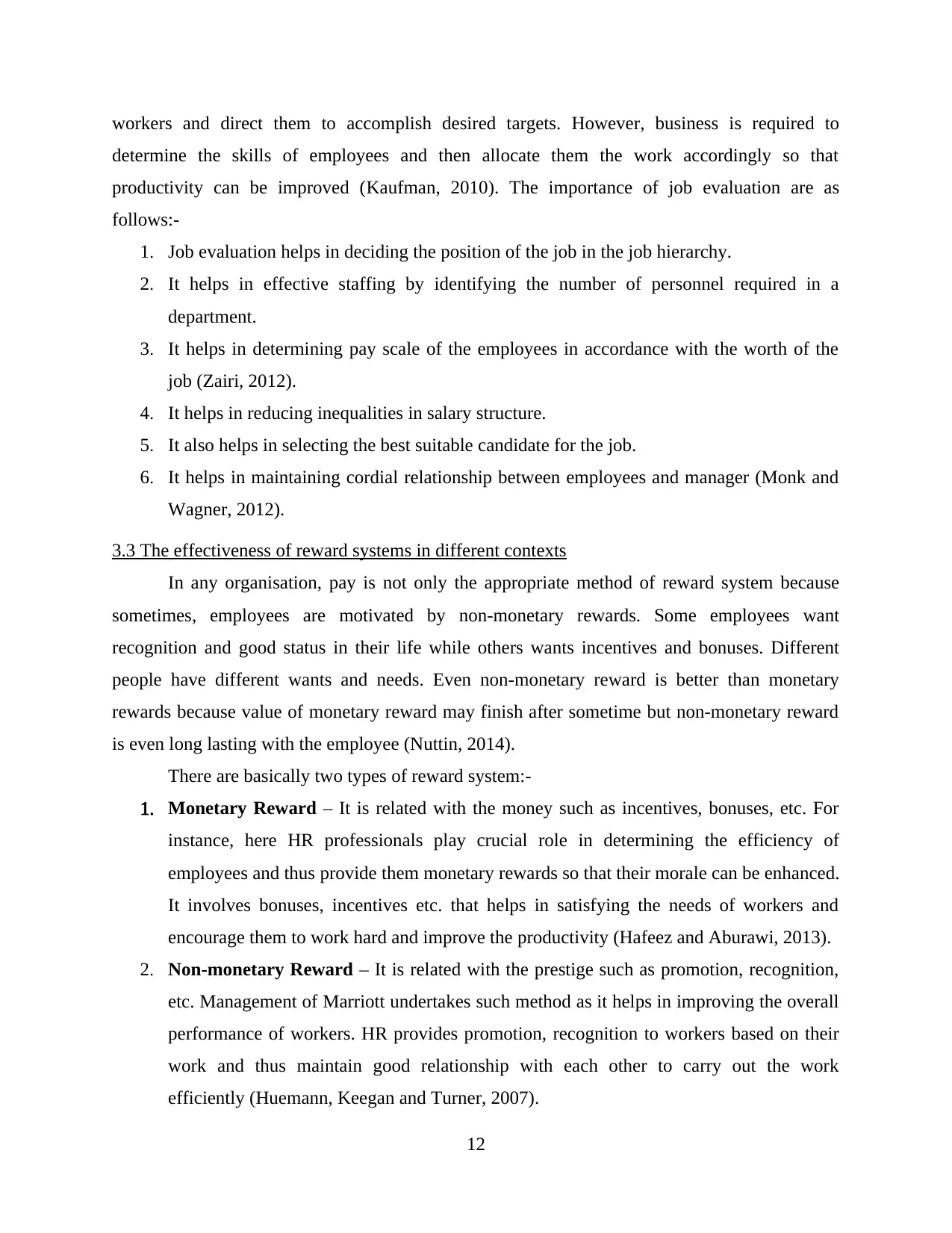
workers and direct them to accomplish desired targets. However, business is required to
determine the skills of employees and then allocate them the work accordingly so that
productivity can be improved (Kaufman, 2010). The importance of job evaluation are as
follows:-
1. Job evaluation helps in deciding the position of the job in the job hierarchy.
2. It helps in effective staffing by identifying the number of personnel required in a
department.
3. It helps in determining pay scale of the employees in accordance with the worth of the
job (Zairi, 2012).
4. It helps in reducing inequalities in salary structure.
5. It also helps in selecting the best suitable candidate for the job.
6. It helps in maintaining cordial relationship between employees and manager (Monk and
Wagner, 2012).
3.3 The effectiveness of reward systems in different contexts
In any organisation, pay is not only the appropriate method of reward system because
sometimes, employees are motivated by non-monetary rewards. Some employees want
recognition and good status in their life while others wants incentives and bonuses. Different
people have different wants and needs. Even non-monetary reward is better than monetary
rewards because value of monetary reward may finish after sometime but non-monetary reward
is even long lasting with the employee (Nuttin, 2014).
There are basically two types of reward system:-
1. Monetary Reward – It is related with the money such as incentives, bonuses, etc. For
instance, here HR professionals play crucial role in determining the efficiency of
employees and thus provide them monetary rewards so that their morale can be enhanced.
It involves bonuses, incentives etc. that helps in satisfying the needs of workers and
encourage them to work hard and improve the productivity (Hafeez and Aburawi, 2013).
2. Non-monetary Reward – It is related with the prestige such as promotion, recognition,
etc. Management of Marriott undertakes such method as it helps in improving the overall
performance of workers. HR provides promotion, recognition to workers based on their
work and thus maintain good relationship with each other to carry out the work
efficiently (Huemann, Keegan and Turner, 2007).
12
determine the skills of employees and then allocate them the work accordingly so that
productivity can be improved (Kaufman, 2010). The importance of job evaluation are as
follows:-
1. Job evaluation helps in deciding the position of the job in the job hierarchy.
2. It helps in effective staffing by identifying the number of personnel required in a
department.
3. It helps in determining pay scale of the employees in accordance with the worth of the
job (Zairi, 2012).
4. It helps in reducing inequalities in salary structure.
5. It also helps in selecting the best suitable candidate for the job.
6. It helps in maintaining cordial relationship between employees and manager (Monk and
Wagner, 2012).
3.3 The effectiveness of reward systems in different contexts
In any organisation, pay is not only the appropriate method of reward system because
sometimes, employees are motivated by non-monetary rewards. Some employees want
recognition and good status in their life while others wants incentives and bonuses. Different
people have different wants and needs. Even non-monetary reward is better than monetary
rewards because value of monetary reward may finish after sometime but non-monetary reward
is even long lasting with the employee (Nuttin, 2014).
There are basically two types of reward system:-
1. Monetary Reward – It is related with the money such as incentives, bonuses, etc. For
instance, here HR professionals play crucial role in determining the efficiency of
employees and thus provide them monetary rewards so that their morale can be enhanced.
It involves bonuses, incentives etc. that helps in satisfying the needs of workers and
encourage them to work hard and improve the productivity (Hafeez and Aburawi, 2013).
2. Non-monetary Reward – It is related with the prestige such as promotion, recognition,
etc. Management of Marriott undertakes such method as it helps in improving the overall
performance of workers. HR provides promotion, recognition to workers based on their
work and thus maintain good relationship with each other to carry out the work
efficiently (Huemann, Keegan and Turner, 2007).
12
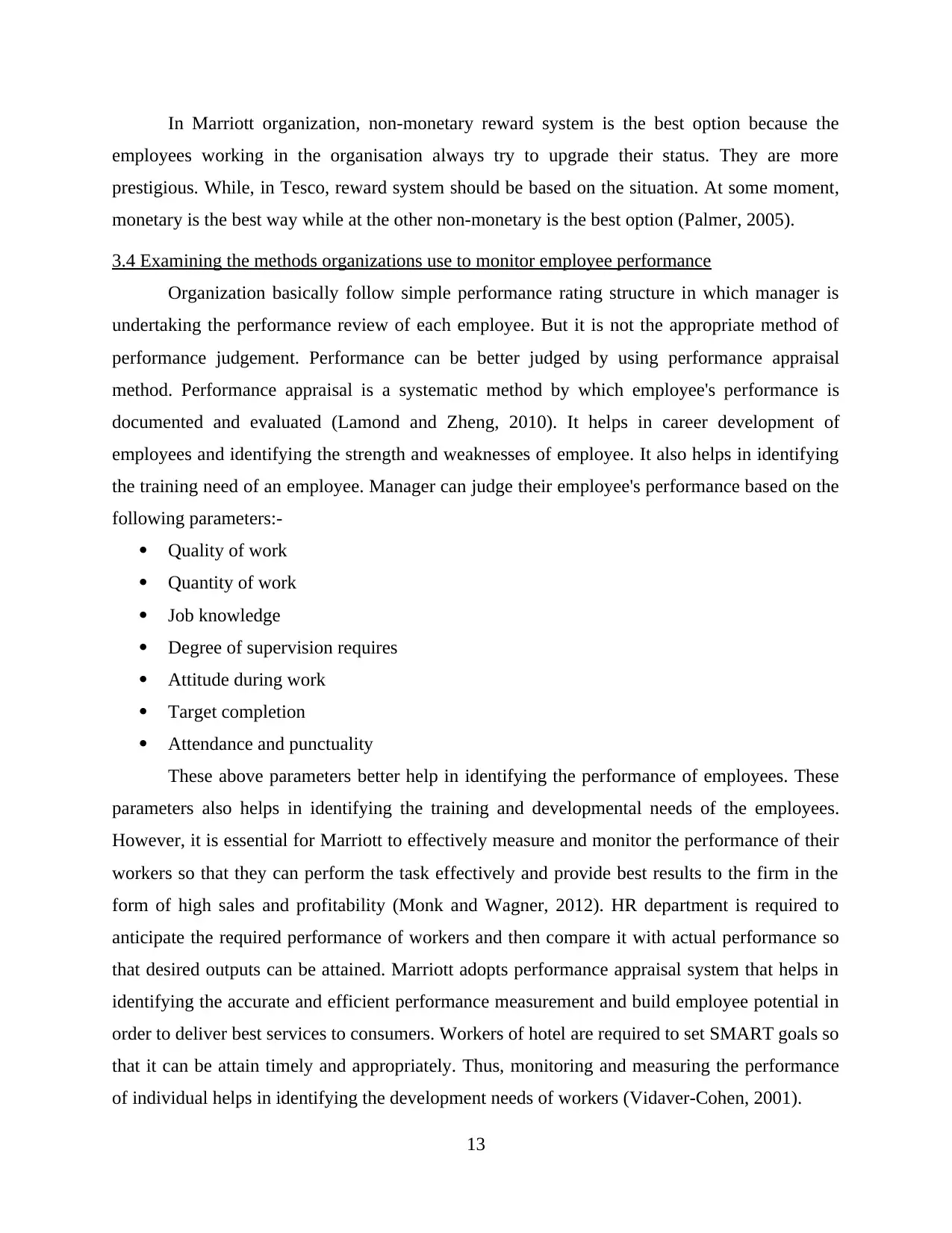
In Marriott organization, non-monetary reward system is the best option because the
employees working in the organisation always try to upgrade their status. They are more
prestigious. While, in Tesco, reward system should be based on the situation. At some moment,
monetary is the best way while at the other non-monetary is the best option (Palmer, 2005).
3.4 Examining the methods organizations use to monitor employee performance
Organization basically follow simple performance rating structure in which manager is
undertaking the performance review of each employee. But it is not the appropriate method of
performance judgement. Performance can be better judged by using performance appraisal
method. Performance appraisal is a systematic method by which employee's performance is
documented and evaluated (Lamond and Zheng, 2010). It helps in career development of
employees and identifying the strength and weaknesses of employee. It also helps in identifying
the training need of an employee. Manager can judge their employee's performance based on the
following parameters:-
Quality of work
Quantity of work
Job knowledge
Degree of supervision requires
Attitude during work
Target completion
Attendance and punctuality
These above parameters better help in identifying the performance of employees. These
parameters also helps in identifying the training and developmental needs of the employees.
However, it is essential for Marriott to effectively measure and monitor the performance of their
workers so that they can perform the task effectively and provide best results to the firm in the
form of high sales and profitability (Monk and Wagner, 2012). HR department is required to
anticipate the required performance of workers and then compare it with actual performance so
that desired outputs can be attained. Marriott adopts performance appraisal system that helps in
identifying the accurate and efficient performance measurement and build employee potential in
order to deliver best services to consumers. Workers of hotel are required to set SMART goals so
that it can be attain timely and appropriately. Thus, monitoring and measuring the performance
of individual helps in identifying the development needs of workers (Vidaver-Cohen, 2001).
13
employees working in the organisation always try to upgrade their status. They are more
prestigious. While, in Tesco, reward system should be based on the situation. At some moment,
monetary is the best way while at the other non-monetary is the best option (Palmer, 2005).
3.4 Examining the methods organizations use to monitor employee performance
Organization basically follow simple performance rating structure in which manager is
undertaking the performance review of each employee. But it is not the appropriate method of
performance judgement. Performance can be better judged by using performance appraisal
method. Performance appraisal is a systematic method by which employee's performance is
documented and evaluated (Lamond and Zheng, 2010). It helps in career development of
employees and identifying the strength and weaknesses of employee. It also helps in identifying
the training need of an employee. Manager can judge their employee's performance based on the
following parameters:-
Quality of work
Quantity of work
Job knowledge
Degree of supervision requires
Attitude during work
Target completion
Attendance and punctuality
These above parameters better help in identifying the performance of employees. These
parameters also helps in identifying the training and developmental needs of the employees.
However, it is essential for Marriott to effectively measure and monitor the performance of their
workers so that they can perform the task effectively and provide best results to the firm in the
form of high sales and profitability (Monk and Wagner, 2012). HR department is required to
anticipate the required performance of workers and then compare it with actual performance so
that desired outputs can be attained. Marriott adopts performance appraisal system that helps in
identifying the accurate and efficient performance measurement and build employee potential in
order to deliver best services to consumers. Workers of hotel are required to set SMART goals so
that it can be attain timely and appropriately. Thus, monitoring and measuring the performance
of individual helps in identifying the development needs of workers (Vidaver-Cohen, 2001).
13
Paraphrase This Document
Need a fresh take? Get an instant paraphrase of this document with our AI Paraphraser
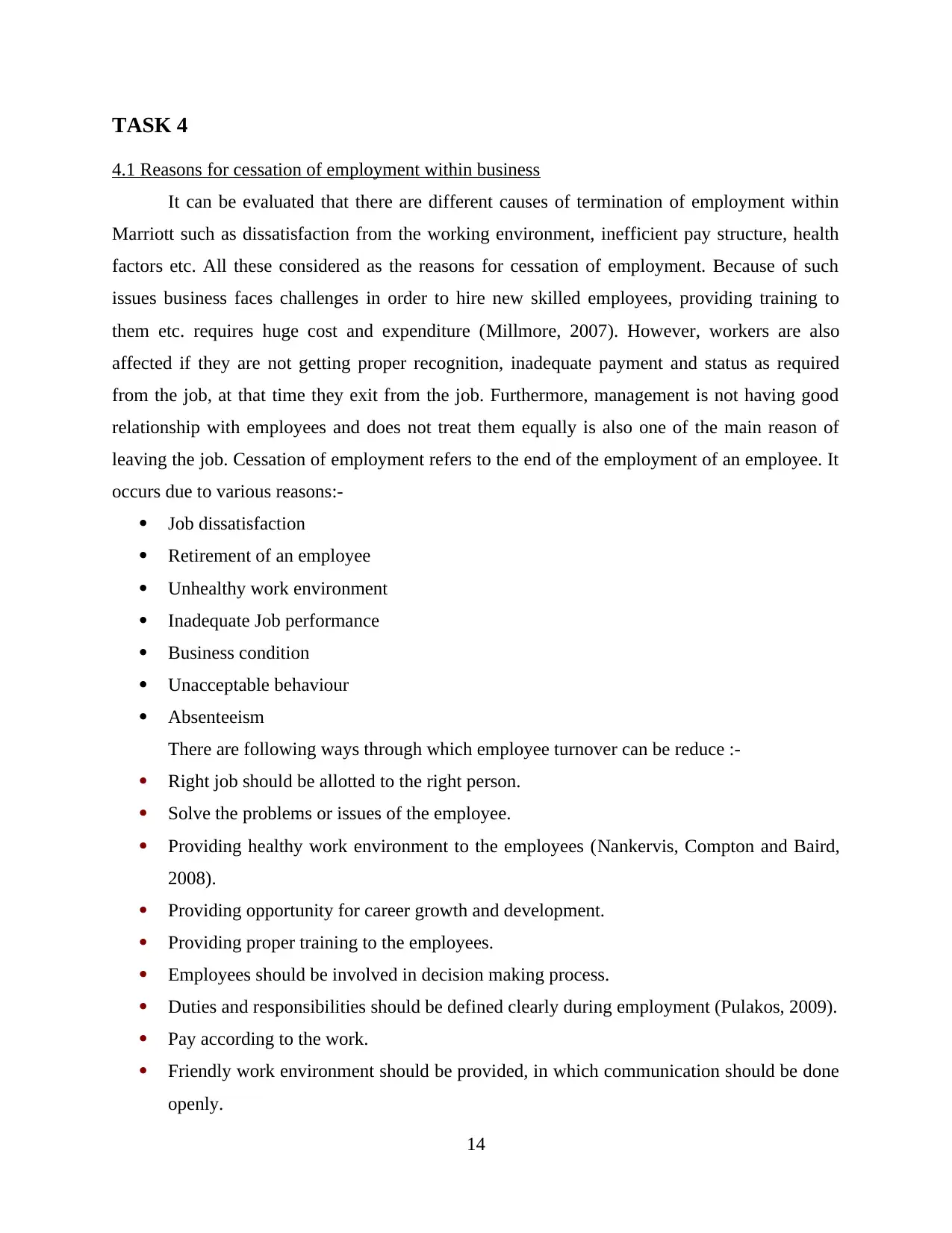
TASK 4
4.1 Reasons for cessation of employment within business
It can be evaluated that there are different causes of termination of employment within
Marriott such as dissatisfaction from the working environment, inefficient pay structure, health
factors etc. All these considered as the reasons for cessation of employment. Because of such
issues business faces challenges in order to hire new skilled employees, providing training to
them etc. requires huge cost and expenditure (Millmore, 2007). However, workers are also
affected if they are not getting proper recognition, inadequate payment and status as required
from the job, at that time they exit from the job. Furthermore, management is not having good
relationship with employees and does not treat them equally is also one of the main reason of
leaving the job. Cessation of employment refers to the end of the employment of an employee. It
occurs due to various reasons:-
Job dissatisfaction
Retirement of an employee
Unhealthy work environment
Inadequate Job performance
Business condition
Unacceptable behaviour
Absenteeism
There are following ways through which employee turnover can be reduce :-
Right job should be allotted to the right person.
Solve the problems or issues of the employee.
Providing healthy work environment to the employees (Nankervis, Compton and Baird,
2008).
Providing opportunity for career growth and development.
Providing proper training to the employees.
Employees should be involved in decision making process.
Duties and responsibilities should be defined clearly during employment (Pulakos, 2009).
Pay according to the work.
Friendly work environment should be provided, in which communication should be done
openly.
14
4.1 Reasons for cessation of employment within business
It can be evaluated that there are different causes of termination of employment within
Marriott such as dissatisfaction from the working environment, inefficient pay structure, health
factors etc. All these considered as the reasons for cessation of employment. Because of such
issues business faces challenges in order to hire new skilled employees, providing training to
them etc. requires huge cost and expenditure (Millmore, 2007). However, workers are also
affected if they are not getting proper recognition, inadequate payment and status as required
from the job, at that time they exit from the job. Furthermore, management is not having good
relationship with employees and does not treat them equally is also one of the main reason of
leaving the job. Cessation of employment refers to the end of the employment of an employee. It
occurs due to various reasons:-
Job dissatisfaction
Retirement of an employee
Unhealthy work environment
Inadequate Job performance
Business condition
Unacceptable behaviour
Absenteeism
There are following ways through which employee turnover can be reduce :-
Right job should be allotted to the right person.
Solve the problems or issues of the employee.
Providing healthy work environment to the employees (Nankervis, Compton and Baird,
2008).
Providing opportunity for career growth and development.
Providing proper training to the employees.
Employees should be involved in decision making process.
Duties and responsibilities should be defined clearly during employment (Pulakos, 2009).
Pay according to the work.
Friendly work environment should be provided, in which communication should be done
openly.
14

4.2 Employment exit procedures used by Marriott and Tesco
In Marriott hotel, exit procedures contains exit interview and retaining strategy. They
take interview of the employee who is leaving the organisation just to find out the reason for
their cessation. And trying to solve their problem and retain them in their organization. They
provide various benefits to these employees for retaining them. But at the same time within
Tesco, there is a simple exit procedure which contain only a resignation letter. They don't even
try to retain those employees and trying to find out their problem. It is because they find skilled
employees easily (Townley, 2014). Also, there is no formal meeting conducting by the employer
with the employees within Tesco at the time of leaving the job and thus final settlement is done.
Exit interview is the interview which is conducted at the time of leaving the organisation.
This interview plays a significant role in identifying the problem faced by the employee. It also
helps in identifying the main reason of employee turnover and in future they try to remove those
problems. It also helps in retaining the talent in the organisation by providing some benefits to
them (Topolosky, 2014). There are different reasons that affects the workers to exit the job. For
instance, workers are not getting required recognition in regard of their work done and
inadequate payment scales affects the satisfaction level of workers. It is one of the major reason
of employees leaving the job. Further, management is also not able to provide best training and
development to their workers that influences the employees and thus they leave the job.
4.3 The impact of the legal and regulatory framework on employment cessation
It can be evaluated that the top management of organization implies different rules and
regulations so that proper legal and regulatory framework could be developed and develop
positive brand image of Marriott in market. UL government implies different laws regarding
employment cessation such as Civil Rights Act 1964 in order to overcome anti-discrimination of
workers on the basis of religion, race, sex and culture etc. Business is required to follow proper
employment rules and regulations so that workers can be satisfied (Strandberg, 2009).
It is essential for organization to develop legal and regulatory framework so that workers
can be protected from termination from work. It safeguards the interest of workers and thus
provide them safe working environment to carry out their operations. For instance, if any
employer is practicing unfair and illegal acts with employees such as extra working hours
without payment, ineffective working environment etc. affects the employees and thus they leave
the job. Thus, government implements different policies such as Equal Opportunities Act,
15
In Marriott hotel, exit procedures contains exit interview and retaining strategy. They
take interview of the employee who is leaving the organisation just to find out the reason for
their cessation. And trying to solve their problem and retain them in their organization. They
provide various benefits to these employees for retaining them. But at the same time within
Tesco, there is a simple exit procedure which contain only a resignation letter. They don't even
try to retain those employees and trying to find out their problem. It is because they find skilled
employees easily (Townley, 2014). Also, there is no formal meeting conducting by the employer
with the employees within Tesco at the time of leaving the job and thus final settlement is done.
Exit interview is the interview which is conducted at the time of leaving the organisation.
This interview plays a significant role in identifying the problem faced by the employee. It also
helps in identifying the main reason of employee turnover and in future they try to remove those
problems. It also helps in retaining the talent in the organisation by providing some benefits to
them (Topolosky, 2014). There are different reasons that affects the workers to exit the job. For
instance, workers are not getting required recognition in regard of their work done and
inadequate payment scales affects the satisfaction level of workers. It is one of the major reason
of employees leaving the job. Further, management is also not able to provide best training and
development to their workers that influences the employees and thus they leave the job.
4.3 The impact of the legal and regulatory framework on employment cessation
It can be evaluated that the top management of organization implies different rules and
regulations so that proper legal and regulatory framework could be developed and develop
positive brand image of Marriott in market. UL government implies different laws regarding
employment cessation such as Civil Rights Act 1964 in order to overcome anti-discrimination of
workers on the basis of religion, race, sex and culture etc. Business is required to follow proper
employment rules and regulations so that workers can be satisfied (Strandberg, 2009).
It is essential for organization to develop legal and regulatory framework so that workers
can be protected from termination from work. It safeguards the interest of workers and thus
provide them safe working environment to carry out their operations. For instance, if any
employer is practicing unfair and illegal acts with employees such as extra working hours
without payment, ineffective working environment etc. affects the employees and thus they leave
the job. Thus, government implements different policies such as Equal Opportunities Act,
15
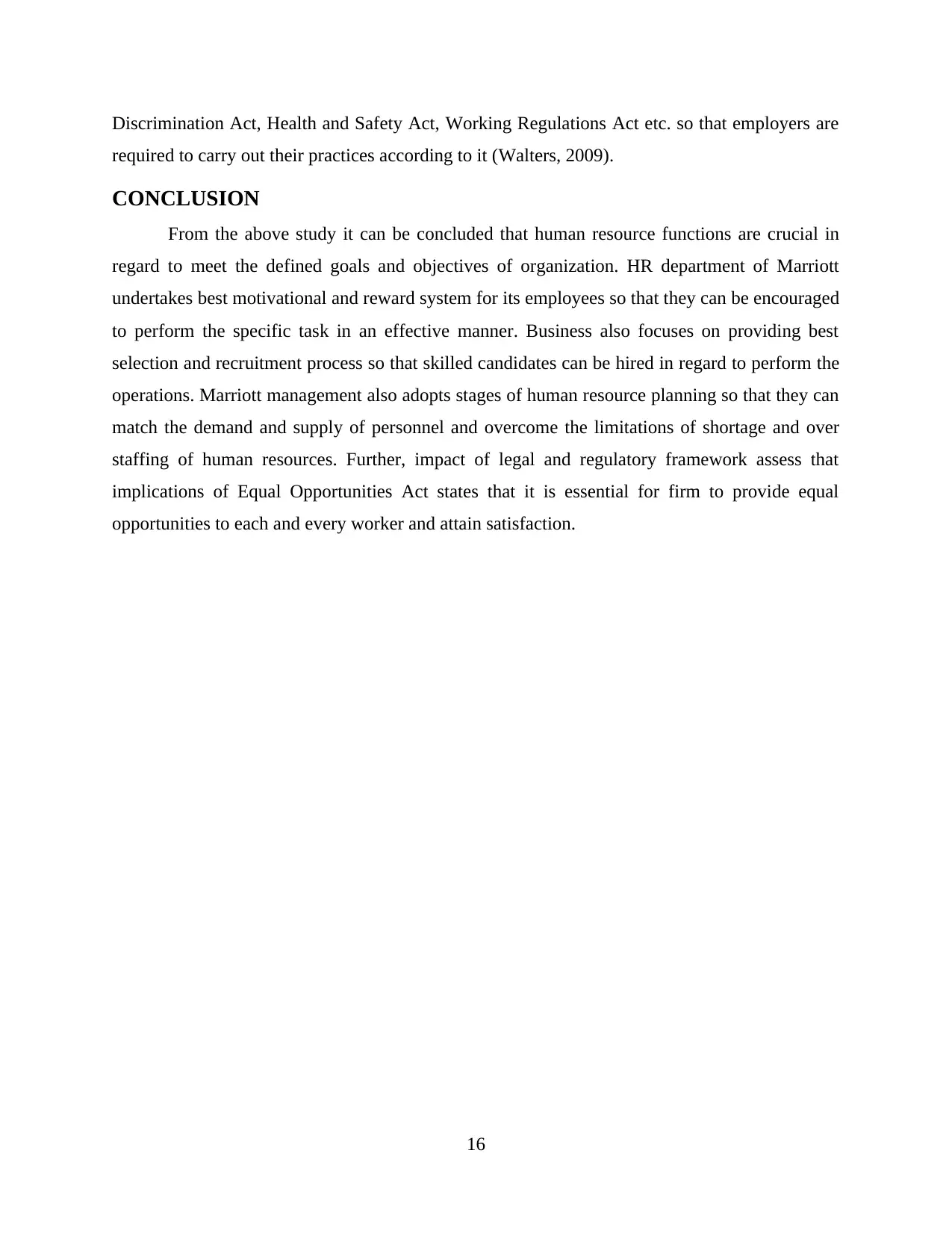
Discrimination Act, Health and Safety Act, Working Regulations Act etc. so that employers are
required to carry out their practices according to it (Walters, 2009).
CONCLUSION
From the above study it can be concluded that human resource functions are crucial in
regard to meet the defined goals and objectives of organization. HR department of Marriott
undertakes best motivational and reward system for its employees so that they can be encouraged
to perform the specific task in an effective manner. Business also focuses on providing best
selection and recruitment process so that skilled candidates can be hired in regard to perform the
operations. Marriott management also adopts stages of human resource planning so that they can
match the demand and supply of personnel and overcome the limitations of shortage and over
staffing of human resources. Further, impact of legal and regulatory framework assess that
implications of Equal Opportunities Act states that it is essential for firm to provide equal
opportunities to each and every worker and attain satisfaction.
16
required to carry out their practices according to it (Walters, 2009).
CONCLUSION
From the above study it can be concluded that human resource functions are crucial in
regard to meet the defined goals and objectives of organization. HR department of Marriott
undertakes best motivational and reward system for its employees so that they can be encouraged
to perform the specific task in an effective manner. Business also focuses on providing best
selection and recruitment process so that skilled candidates can be hired in regard to perform the
operations. Marriott management also adopts stages of human resource planning so that they can
match the demand and supply of personnel and overcome the limitations of shortage and over
staffing of human resources. Further, impact of legal and regulatory framework assess that
implications of Equal Opportunities Act states that it is essential for firm to provide equal
opportunities to each and every worker and attain satisfaction.
16
Secure Best Marks with AI Grader
Need help grading? Try our AI Grader for instant feedback on your assignments.
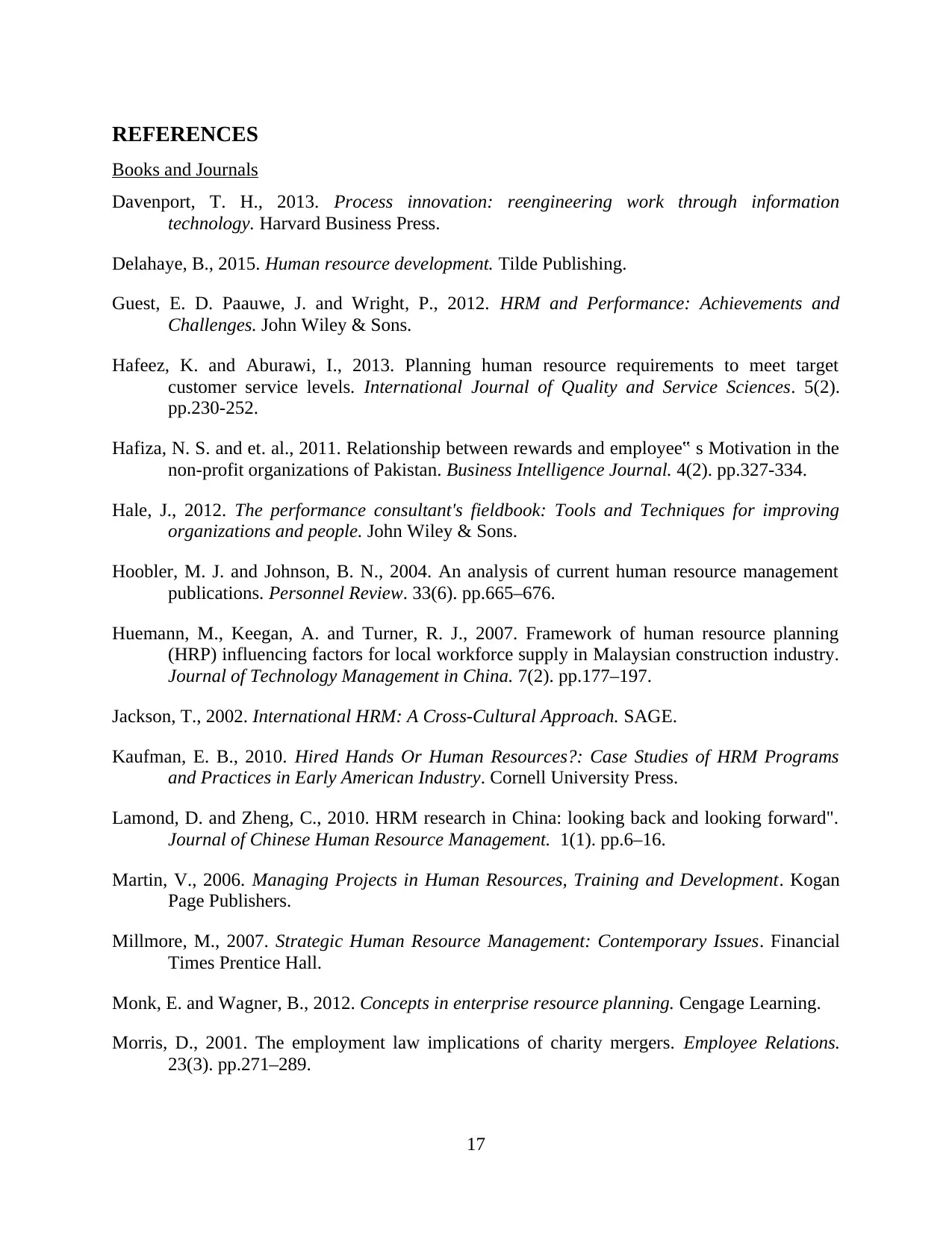
REFERENCES
Books and Journals
Davenport, T. H., 2013. Process innovation: reengineering work through information
technology. Harvard Business Press.
Delahaye, B., 2015. Human resource development. Tilde Publishing.
Guest, E. D. Paauwe, J. and Wright, P., 2012. HRM and Performance: Achievements and
Challenges. John Wiley & Sons.
Hafeez, K. and Aburawi, I., 2013. Planning human resource requirements to meet target
customer service levels. International Journal of Quality and Service Sciences. 5(2).
pp.230-252.
Hafiza, N. S. and et. al., 2011. Relationship between rewards and employee‟ s Motivation in the
non-profit organizations of Pakistan. Business Intelligence Journal. 4(2). pp.327-334.
Hale, J., 2012. The performance consultant's fieldbook: Tools and Techniques for improving
organizations and people. John Wiley & Sons.
Hoobler, M. J. and Johnson, B. N., 2004. An analysis of current human resource management
publications. Personnel Review. 33(6). pp.665–676.
Huemann, M., Keegan, A. and Turner, R. J., 2007. Framework of human resource planning
(HRP) influencing factors for local workforce supply in Malaysian construction industry.
Journal of Technology Management in China. 7(2). pp.177–197.
Jackson, T., 2002. International HRM: A Cross-Cultural Approach. SAGE.
Kaufman, E. B., 2010. Hired Hands Or Human Resources?: Case Studies of HRM Programs
and Practices in Early American Industry. Cornell University Press.
Lamond, D. and Zheng, C., 2010. HRM research in China: looking back and looking forward".
Journal of Chinese Human Resource Management. 1(1). pp.6–16.
Martin, V., 2006. Managing Projects in Human Resources, Training and Development. Kogan
Page Publishers.
Millmore, M., 2007. Strategic Human Resource Management: Contemporary Issues. Financial
Times Prentice Hall.
Monk, E. and Wagner, B., 2012. Concepts in enterprise resource planning. Cengage Learning.
Morris, D., 2001. The employment law implications of charity mergers. Employee Relations.
23(3). pp.271–289.
17
Books and Journals
Davenport, T. H., 2013. Process innovation: reengineering work through information
technology. Harvard Business Press.
Delahaye, B., 2015. Human resource development. Tilde Publishing.
Guest, E. D. Paauwe, J. and Wright, P., 2012. HRM and Performance: Achievements and
Challenges. John Wiley & Sons.
Hafeez, K. and Aburawi, I., 2013. Planning human resource requirements to meet target
customer service levels. International Journal of Quality and Service Sciences. 5(2).
pp.230-252.
Hafiza, N. S. and et. al., 2011. Relationship between rewards and employee‟ s Motivation in the
non-profit organizations of Pakistan. Business Intelligence Journal. 4(2). pp.327-334.
Hale, J., 2012. The performance consultant's fieldbook: Tools and Techniques for improving
organizations and people. John Wiley & Sons.
Hoobler, M. J. and Johnson, B. N., 2004. An analysis of current human resource management
publications. Personnel Review. 33(6). pp.665–676.
Huemann, M., Keegan, A. and Turner, R. J., 2007. Framework of human resource planning
(HRP) influencing factors for local workforce supply in Malaysian construction industry.
Journal of Technology Management in China. 7(2). pp.177–197.
Jackson, T., 2002. International HRM: A Cross-Cultural Approach. SAGE.
Kaufman, E. B., 2010. Hired Hands Or Human Resources?: Case Studies of HRM Programs
and Practices in Early American Industry. Cornell University Press.
Lamond, D. and Zheng, C., 2010. HRM research in China: looking back and looking forward".
Journal of Chinese Human Resource Management. 1(1). pp.6–16.
Martin, V., 2006. Managing Projects in Human Resources, Training and Development. Kogan
Page Publishers.
Millmore, M., 2007. Strategic Human Resource Management: Contemporary Issues. Financial
Times Prentice Hall.
Monk, E. and Wagner, B., 2012. Concepts in enterprise resource planning. Cengage Learning.
Morris, D., 2001. The employment law implications of charity mergers. Employee Relations.
23(3). pp.271–289.
17
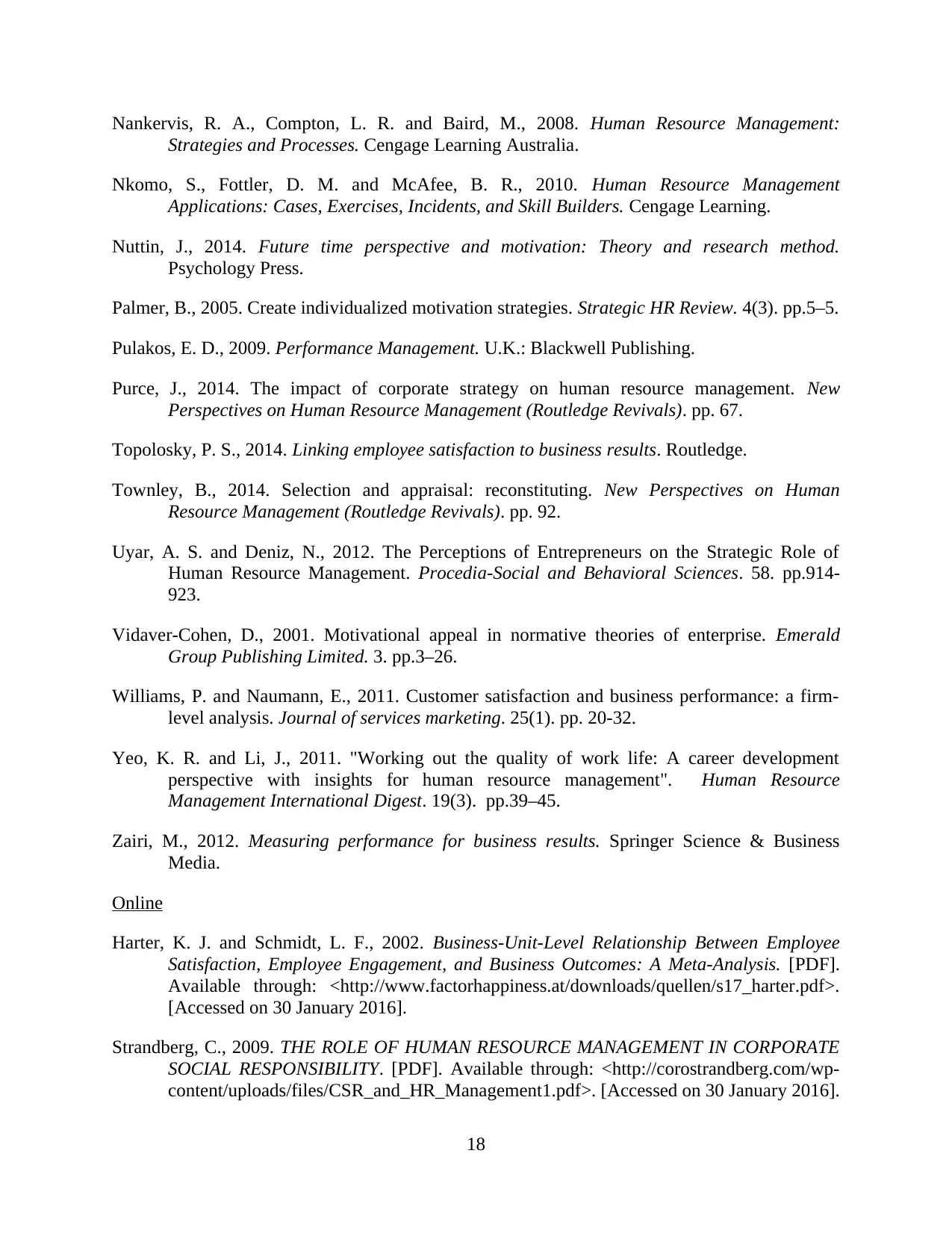
Nankervis, R. A., Compton, L. R. and Baird, M., 2008. Human Resource Management:
Strategies and Processes. Cengage Learning Australia.
Nkomo, S., Fottler, D. M. and McAfee, B. R., 2010. Human Resource Management
Applications: Cases, Exercises, Incidents, and Skill Builders. Cengage Learning.
Nuttin, J., 2014. Future time perspective and motivation: Theory and research method.
Psychology Press.
Palmer, B., 2005. Create individualized motivation strategies. Strategic HR Review. 4(3). pp.5–5.
Pulakos, E. D., 2009. Performance Management. U.K.: Blackwell Publishing.
Purce, J., 2014. The impact of corporate strategy on human resource management. New
Perspectives on Human Resource Management (Routledge Revivals). pp. 67.
Topolosky, P. S., 2014. Linking employee satisfaction to business results. Routledge.
Townley, B., 2014. Selection and appraisal: reconstituting. New Perspectives on Human
Resource Management (Routledge Revivals). pp. 92.
Uyar, A. S. and Deniz, N., 2012. The Perceptions of Entrepreneurs on the Strategic Role of
Human Resource Management. Procedia-Social and Behavioral Sciences. 58. pp.914-
923.
Vidaver-Cohen, D., 2001. Motivational appeal in normative theories of enterprise. Emerald
Group Publishing Limited. 3. pp.3–26.
Williams, P. and Naumann, E., 2011. Customer satisfaction and business performance: a firm-
level analysis. Journal of services marketing. 25(1). pp. 20-32.
Yeo, K. R. and Li, J., 2011. "Working out the quality of work life: A career development
perspective with insights for human resource management". Human Resource
Management International Digest. 19(3). pp.39–45.
Zairi, M., 2012. Measuring performance for business results. Springer Science & Business
Media.
Online
Harter, K. J. and Schmidt, L. F., 2002. Business-Unit-Level Relationship Between Employee
Satisfaction, Employee Engagement, and Business Outcomes: A Meta-Analysis. [PDF].
Available through: <http://www.factorhappiness.at/downloads/quellen/s17_harter.pdf>.
[Accessed on 30 January 2016].
Strandberg, C., 2009. THE ROLE OF HUMAN RESOURCE MANAGEMENT IN CORPORATE
SOCIAL RESPONSIBILITY. [PDF]. Available through: <http://corostrandberg.com/wp-
content/uploads/files/CSR_and_HR_Management1.pdf>. [Accessed on 30 January 2016].
18
Strategies and Processes. Cengage Learning Australia.
Nkomo, S., Fottler, D. M. and McAfee, B. R., 2010. Human Resource Management
Applications: Cases, Exercises, Incidents, and Skill Builders. Cengage Learning.
Nuttin, J., 2014. Future time perspective and motivation: Theory and research method.
Psychology Press.
Palmer, B., 2005. Create individualized motivation strategies. Strategic HR Review. 4(3). pp.5–5.
Pulakos, E. D., 2009. Performance Management. U.K.: Blackwell Publishing.
Purce, J., 2014. The impact of corporate strategy on human resource management. New
Perspectives on Human Resource Management (Routledge Revivals). pp. 67.
Topolosky, P. S., 2014. Linking employee satisfaction to business results. Routledge.
Townley, B., 2014. Selection and appraisal: reconstituting. New Perspectives on Human
Resource Management (Routledge Revivals). pp. 92.
Uyar, A. S. and Deniz, N., 2012. The Perceptions of Entrepreneurs on the Strategic Role of
Human Resource Management. Procedia-Social and Behavioral Sciences. 58. pp.914-
923.
Vidaver-Cohen, D., 2001. Motivational appeal in normative theories of enterprise. Emerald
Group Publishing Limited. 3. pp.3–26.
Williams, P. and Naumann, E., 2011. Customer satisfaction and business performance: a firm-
level analysis. Journal of services marketing. 25(1). pp. 20-32.
Yeo, K. R. and Li, J., 2011. "Working out the quality of work life: A career development
perspective with insights for human resource management". Human Resource
Management International Digest. 19(3). pp.39–45.
Zairi, M., 2012. Measuring performance for business results. Springer Science & Business
Media.
Online
Harter, K. J. and Schmidt, L. F., 2002. Business-Unit-Level Relationship Between Employee
Satisfaction, Employee Engagement, and Business Outcomes: A Meta-Analysis. [PDF].
Available through: <http://www.factorhappiness.at/downloads/quellen/s17_harter.pdf>.
[Accessed on 30 January 2016].
Strandberg, C., 2009. THE ROLE OF HUMAN RESOURCE MANAGEMENT IN CORPORATE
SOCIAL RESPONSIBILITY. [PDF]. Available through: <http://corostrandberg.com/wp-
content/uploads/files/CSR_and_HR_Management1.pdf>. [Accessed on 30 January 2016].
18
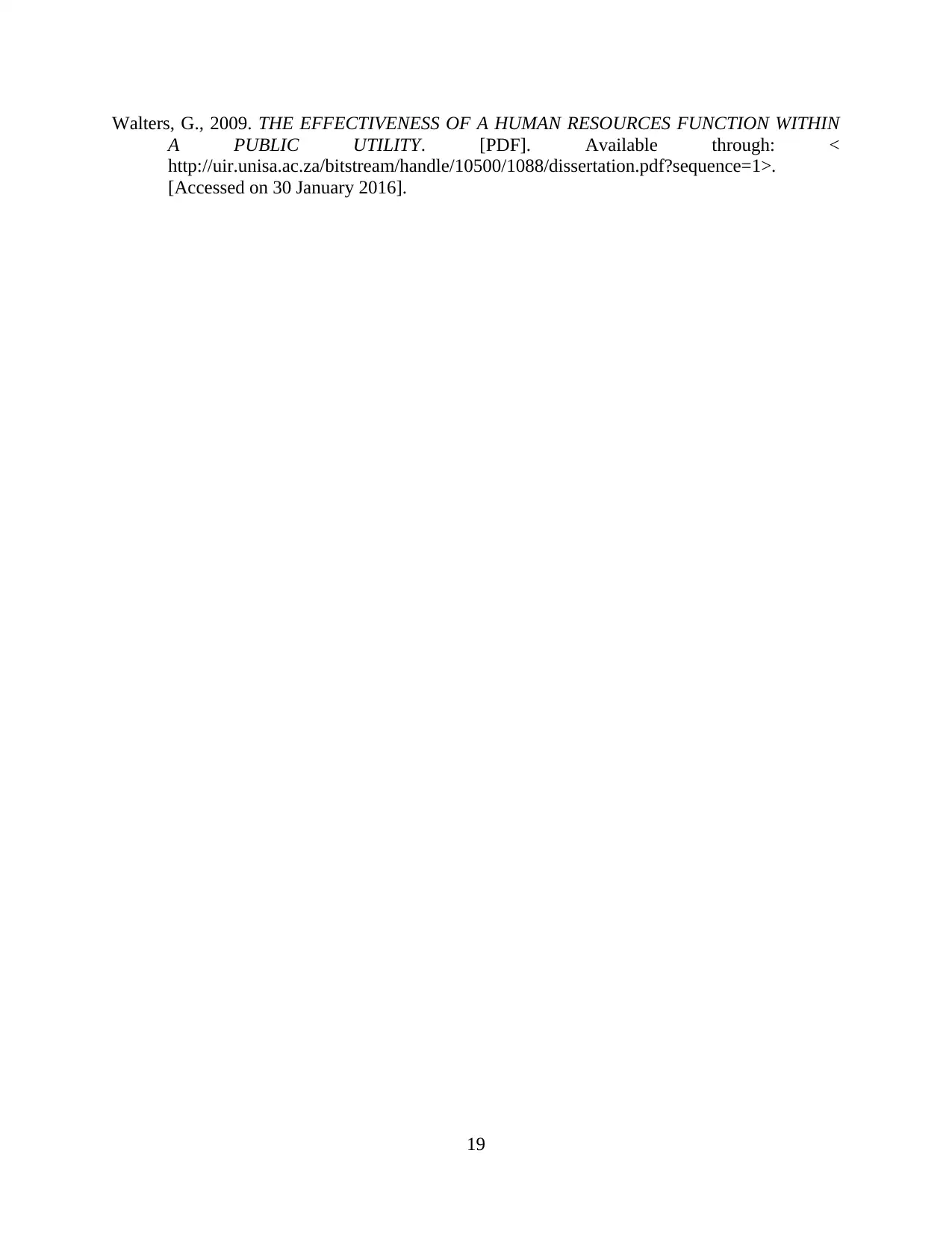
Walters, G., 2009. THE EFFECTIVENESS OF A HUMAN RESOURCES FUNCTION WITHIN
A PUBLIC UTILITY. [PDF]. Available through: <
http://uir.unisa.ac.za/bitstream/handle/10500/1088/dissertation.pdf?sequence=1>.
[Accessed on 30 January 2016].
19
A PUBLIC UTILITY. [PDF]. Available through: <
http://uir.unisa.ac.za/bitstream/handle/10500/1088/dissertation.pdf?sequence=1>.
[Accessed on 30 January 2016].
19
1 out of 19
Related Documents
Your All-in-One AI-Powered Toolkit for Academic Success.
+13062052269
info@desklib.com
Available 24*7 on WhatsApp / Email
![[object Object]](/_next/static/media/star-bottom.7253800d.svg)
Unlock your academic potential
© 2024 | Zucol Services PVT LTD | All rights reserved.





